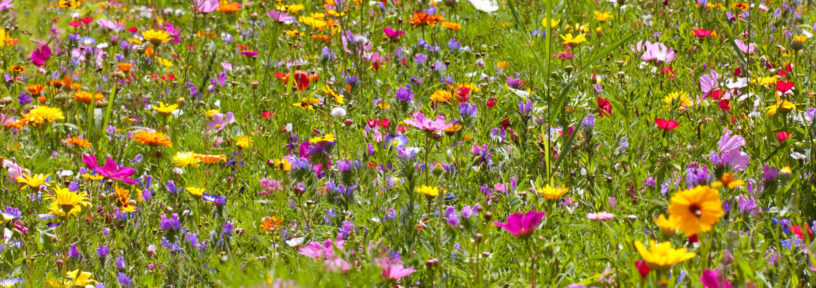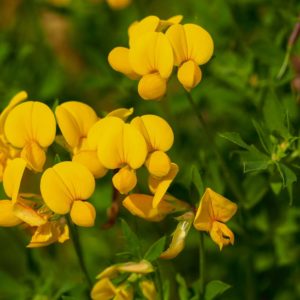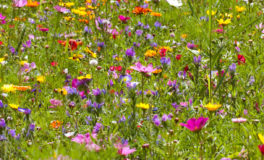Meadowmat Species – This article contains a list of all the flower varieties that are contained in our Wildflower Turf products.
Table of Contents (click each heading for further information on each flower)
Agrimony (Agrimonia Eupatoria)
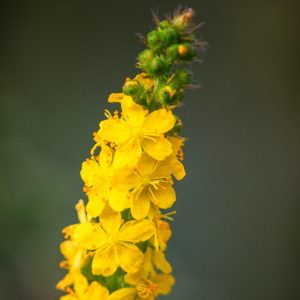
Agrimonia eupatoria is a yellow wildflower more commonly known as common agrimony, church steeples or sticklewort. Incorporated into Meadowmat for Birds and Bees, this deciduous, perennial herbaceous plant is a native species to the UK. It grows to about 100 cm (1-2 feet). It is covered in soft hairs, the plant has serrated edged pinnate leaves and a striking spike of five-petalled yellow flowers that bloom throughout the summer months of June, July and August. The flowers have a faint smell of apricots and have a generous pollen supply that is ideal to attract hoverflies, flies and honey bees.
Once pollinated, the flowers develop into red-brown hooked burs that are distributed via the coats of cattle, sheep and deer, as well as any passing humans.
Where to find agrimony
Agrimonia eupatoria likes neutral or chalky soils. It is usually found in rough grassland where its tall structure, growing in clumps, can provide shelter for butterflies, mice and voles. It also provides a great habitat for birds. Agrimony is also commonly found in field borders, hedgerows and woodland edges and it is listed in the RHS Perfect for Pollinators list. For garden growing, agrimony prefers sun or partial shade and regular watering. It can be grown from seed or propagation by dividing the root in the spring or autumn. Agrimony is unlikely to do well in shade or wet acidic soils.
Traditional uses for agrimony
Being abundant throughout the UK, although not in the north of Scotland, agrimonia eupatoria has been used in herbal medicine for hundreds of years; the Anglo-Saxons identified its healing properties and used it extensively for wounds, snake bites and warts. In later times it was used to treat gunshot wounds.
The herb features extensively in folklore; witches used agrimony in spells and to ward off hexes, while those practising voodoo would use it to repel jinxes and block curses. People would often hang a sachet of it in their homes to protect them against goblins, evil spirits and poisoning. Even today, practising Wiccans put agrimony leaves in a pillowcase to ensure a good night’s sleep.
Agrimony remains a trusted treatment as a mild astringent and tonic, and is considered effective in the treatment of coughs, sore throats and diarrhoea (it is often administered with honey or sugar). Oil of agrimony is high in tannin and is used to treat ulcers, blemishes and spots and, owing to the tannin, it is recommended as an effective leather dressing.
Key facts about Agrimony
- Height: 10-50cm
- Flowering Time: June – August
- Flower colour: Yellow
- Habitat: Meadows, hedgerows, woodland margins, rocky slopes, field borders
Achillea Millefollium
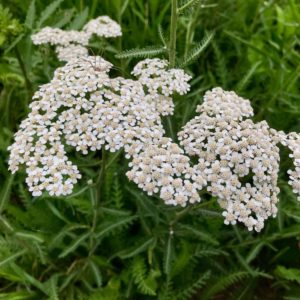
Also known as Common Yarrow – It is a strong, sweet smelling perennial wildflower, which can typically be found growing in grassland, on the roadside verges and on waste ground. The appearance of its leaves is fern-like, feathery, and finely divided and are dark green in colour. The flower heads are small, white flat-topped densely arranged clusters.
Uses for Common Yarrow
There are many health benefits of Yarrow as it is an herb and has been used medicinally for centuries now. It was once used on wounded soldiers to stop their bleeding and prevent infection. Yarrow is still one of the most widely use medicinal herbs today to aid healing for many complaints and conditions such as a fever, the common cold, hay fever and toothache. It is also used as an anti-inflammatory.
Why grow Common Yarrow?
- Easy to grow
- Not too fussy and tolerates a variety of soil conditions
- Bee friendly
- Butterfly friendly
- Use for therapeutic medicinal purposes
- Looks and smells beautiful!
- Perennial
Key facts about Achillea Millefollium
- Height: 10-50cm
- Flowering Time: June – August
- Flower colour: White
- Habitat: Loves growing in the sunshine in the wild, coastal or in rock garden areas
Autumn Hawkbit (Scorzoneroids Autumnalis)
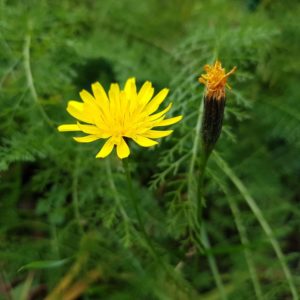
Autumn Hawkbit – Latin name Scorzoneroids autumnalis – is a very common plant in Eurasia (eastern Europe to western Siberia) where it’s a native species, and is part of the daisy family. More recently it’s also been introduced to North America. It looks so similar to the familiar dandelion that is is sometimes referred to as the fall dandelion. The Latin name of the Hawkbit’s gens (Leontodon) literally translates to Lion’s Tooth. This is due to the jagged edges of the flower’s petals. Rather interestingly, the name “Hawkbit” stems from the ancient belief that hawks used to eat this plant to improve their eyesight. The plant itself grows between 15 and 30 cm in height.
How to recognise Autumn Hawkbit
This yellow wildflower can be spotted from July to September, as this is when the plant flowers. The plant grows one single wildflower per stem, each around 2.5 to 3cm (or 1 to 1.2 inches) in diameter and surrounded by involucral brats. In colour the flowers are naturally yellow – hence their similarity to to dandelion – but with a slight red tinge to the outer edges of their petals. The tips to the petals are five toothed.
In terms of scent, Scorzoneroids autunmalis only gives off a very faint one, but it is described as similar to that of a pansy and rather pungent.
Where to see Autumn Hawkbit
Autumn Hawkbit thrives in many environments, but its most common habitats are the seashores, snow-bed sites, rocky outcrops, fell tundra meadows, roadsides, lawns, paths, yards, wasteland and pastures. It’s mostly found on sites with more than 20 weeks of dry soil per year and 10 – 20 weeks of wet soil per year. The Autumn Hawkbit requires relatively fertile soil to grow in high numbers. It’s also a good indicator of old meadows.
A great plant for pollinators
This wildflower is on the RHS “Perfect for Pollinators” list, meaning it’s of benefit to and gets many a visit from the butterflies and bees. However, beware of the ‘tephritis leontondontist’ fly as it is known to attack the capitula (flower head) of this particular plant. The Hawkbit is a perennial plant and is a welcome sight in managed grassland and hay meadows.
Key facts about Autumn Hawkbit
- Height: 10-50cm
- Flowering Time: July – October
- Flower colour: Yellow
- Habitat: Rocky or grassy places, pathways, meadows, waste areas.
Betony (Stachys Officinalis)
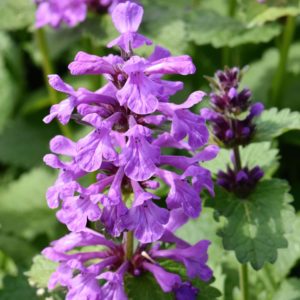
Betony (scientific name: Stachys officinalis) is a perennial herb with light purple flowers. A native species in Europe, North Africa and Asia, the appearance of this purple wildflower is sporadic in these zones; for example it grows in abundance in England and Wales, in heathlands, grassy fields and hedgerows, but not in northern Britain. Betony reaches from one to two feet tall and blossoms in the summer months. Its light purple flowers are spike-shaped, hence its Latin name of Stachys. Turfonline recommends it as a wildflower for your garden or wildflower patch; RHS have deemed it perfect for pollinators, attracting bees and butterflies, and with its purple blossom betony looks wonderful in any garden or wild meadow.
Growing and harvesting Betony
Betony is a hardy herb and grows in average soil, and though it prefers partial shade it will often thrive in strong sunshine. To introduce betony, plant a generous amount of seeds and, when they flower – usually from late July to September – divide them and replant.
To harvest, cut the entire plant at the base of the stem, and hang to dry in a cool, dark place. Once dried, crumble the herb and use it for tea – it’s a popular herbal infusion which is said to aid several ailments and health conditions. To preserve the herb keep it dry. The best way of doing this is to store it in jars or wooden boxes.
Traditional uses for Betony
Betony has a long history as a popular and restorative plant, both for medicinal and spiritual purposes. It was a traditional feature of monasteries’ physic gardens and apothecaries. It was grown and used for medicinal purposes, and can be commonly seen today in churchyards. Betony was planted here because it was believed to be effective in warding off evil spirits. So although little known today, Betony was once a highly valued plant; indeed it features in an Italian proverb: Venda la onica e compra beonica (sell your coat and buy betony), and a traditional Spanish saying: Él tiene tantas virtudes como betony (he has as many virtues as betony), attesting to its many qualities, known internationally.
These days Betony is most commonly used as a tea or herbal infusion. Part of the mint family, Betony has both stimulating and relaxant properties and is also an astringent. It is used to treat headaches, neuralgia, heartburn and anxiety. It is also mixed with honey to treat colds and coughs.
Key facts about Betony
- Height: 50-100cm
- Flowering Time: June – September
- Flower colour: Purple
- Habitat: prefers dry soils often found on banks, hedgerows, heathland, woodland and other grassy areas.
Birdsfoot Trefoil (Lotus Corniculatus)
As sure as eggs are eggs you will have seen Birdsfoot Trefoil growing somewhere. You may know it by its other name “eggs and bacon”. A very sensible name since the yellow flowers are often streaked with red or orange and the buds are nearly always red.
Why is it called “Birdsfoot”? The answer to that question lies in the seed heads. Each seed-head consists of three, skinny pods (hence trefoil) and they look just like a bird’s foot. Break one of the pods and seeds will ping out in all directions.
Also with three lobes is the triplet of leaves part way up the stem. Leaves near to the ground have five leaflets.
Leaves look a little bit like pea or vetch leaves. Not surprisingly since Birdsfoot trefoil is also a legume and can fix nitrogen in the soil
Uses for Birdsfoot Trefoil
Beekeepers adore this plant and for good reason. Not only does it have a long flowering season, but the pollen is extremely rich in protein. A vital source of nutrients for baby bees of all species. It is also the larval food plant of the Common Blue, Green Hairstreak and Dingy Skipper butterflies.
All parts of this plant are poisonous to people – but only if you eat them. I’m given to understand that Birdsfoot trefoil makes an excellent anti-inflammatory dressing for skin conditions.
Another traditional use for Birdsfoot Trefoil flowers is to make an orangy-yellow coloured dye. My favourite use for this plant though is a little more mystical. The flowers are traditionally woven into wreaths on midsummer night. We don’t know why – perhaps because the 3-lobed leaves remind people of the holy trinity. I suspect the custom might be older than Christianity though. Maybe the flowers were used as part of a celebration for the simple reason that they’re pretty?
In the garden, Birdsfoot Trefoil is pretty grown in pots but excels as part of a species rich lawn. Its low growing, tolerates occasional mowing and provides a cheery splash of colour all summer long. Birdsfoot trefoil also makes a good green manure. Grow it in your veggie beds over the winter and then dig the leaves into the soil before sowing your food crops. It will help keep the soil in good heart.
Why grow Birdsfoot Trefoil?
We’ve included Birdsfoot Trefoil in every variety of Meadowmat for lots of good reasons
- Easy to grow
- Bee friendly
- Butterfly friendly
- Low growing
- Not too fussy about soil type
- Copes with dappled shade
- Tolerates mowing well
- Frost hardy
- Perennial
Key facts about Birdsfoot Trefoil
- Height: 10-50cm
- Flowering Time: May – September
- Flower colour: Bright golden yellow flowers with red buds
- Habitat: Loves living in grassland with lots of sunshine. Birdsfoot Trefoil is common throughout the UK the only soil type it struggles with is very acidic soil.
Black Medick (Medicago Lupulina)
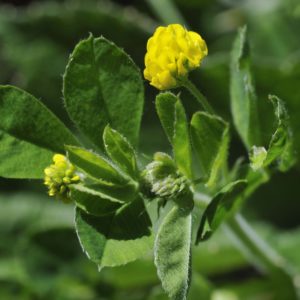
It’s easy to mistake Black Medick for clover – until you see the two species side by side. Black Medick has the three lobed leaves like so many legumes but they are smaller than clover, more delicate and more widely spaced.
The flowers are tiny and look like little yellow baubles on the ground. Look closer and you’ll see that they are made from lots of small flowers, each one a similar shape to a vetch or a pea flower. For Black medick comes from that very special family of flowers who can fix nitrogen into the soil.
Uses for Black Medick
The name of this plant implies that it has some sort of medicinal use. It does reportedly have a mild laxative effect when eaten but the name has nothing to do with any remedies. It actually means “plant of the Medes”, a people of ancient Persia.
Black Medick is an excellent fodder crop. It’s early flowering habit also makes it a favourite plant of bumble bees and honey bees.
The leaves and seeds are edible. Some historians believe that Native Americans may have roasted the seeds or ground them into flour. Add some leaves to a salad – but taste them first. Some say they have quite a bitter flavour.
We’ve included Black medick in our species rich turf for several reasons
- Bee friendly
- Low growing
- Tolerates mowing well
- Frost hardy
- Perennial
- Cheery coloured flowers
Species rich turf is for low maintenance natural lawns. Mow once a fortnight and enjoy seeing all the wildlife visit your garden.
Key facts about Black Medick
- Height: 5-60cm
- Flowering Time: May – August
- Flower colour: Bright yellow
- Habitat: Very common in the UK. Find Black medick on mown grassland as well as dry grassland and disturbed calcareous soils. Prefers to grow in full sun.
Bladder Campion (Silene Vulgaris)
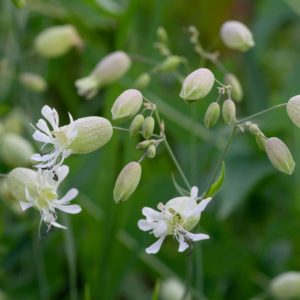
Bladder campion (silene vulgaris) is a perennial white wildflower with waxy, bluish-green leaves. It blooms from May to September and grows to between one and three feet. Part of the Pink family, it is a native species to Europe but widespread across North America. A familiar sight across the UK, but most concentrated in England, bladder campion is one of seven Silene species native to this country, and grows in several habitats including, meadows, grasslands, fields, roadside verges and hedgerows. It gets its name from its calyx – that is, the balloon-shaped swellings that grow just behind the white flowers. Its white (and sometimes pink) wildflowers are in bloom from May to September and it has a pleasant clove-like aroma.
Like many wildflowers, bladder campion is named by the Royal Horticultural Society (RHS) as ‘Perfect for Pollinators‘; its rich nectar attracts bumble bees, butterflies and other insects that help support the eco-system and promote biodiversity.
Growing And Harvesting Bladder Campion
Bladder campion grows easily – just plant a handful of seeds at any time of year. It makes an attractive addition to a wildflower meadow or rock garden.
As an alternative to growing your own bladder campion, you can keep things really simple and invest in Meadowmat, a pre-grown wildflower meadow that’s as easy to lay as lawn turf. Meadowmat and organisations such as the Royal Horticultural Society (RHS) and local Wildlife Trusts can provide further advice and tips on how to plant wildflowers and their many benefits.
Traditional Uses for Bladder Campion
Bladder campion attracts pollinators, other insects, and birds, so it makes the perfect addition to a wildflower garden. Bladder campion is not known for its medicinal qualities, but it does have several culinary uses. It is very nutritious, high in omega 3 and packed with antioxidants. When the leaves are young, they can be added to salads and eaten raw. Mature leaves tend to be more bitter and should be blanched or steamed, in the same way, other leafy vegetables are cooked and can be added to stir-fries and soups.
Bladder campion has long been a popular choice with foragers, particularly in Spain, where it is a key ingredient in recipes such as ‘gazpacho viudo’ (widower gazpacho), a soup made in the La Mancha region of the country with the plant’s stewed leaves and eaten with a local flatbread.
Key facts about Bladder Campion
- Height: 50-100cm
- Flowering Time: June – August
- Flower colour: White
- Habitat: Often found in meadows, grasslands and fields. Also found in hedgerows and roadside verges
Catsear (Hypochaeris Radicata)
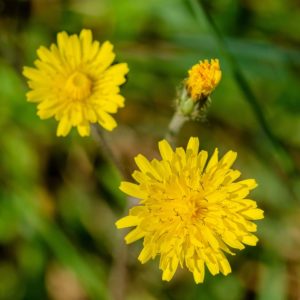
Catsear (hypochaeris radicata) is a perennial yellow wildflower, very similar in appearance to the dandelion and often mistaken for it – in fact, Catsear’s other names include false dandelion. There are several ways to identify a Catsear correctly; for example, it has hairy leaves, while a dandelion’s are smooth. A Catsear also has slightly more rounded leaves than a dandelion.
A native species in Europe, Catsear also grows much further afield, in countries including Australia, New Zealand, the USA and Japan. Catsear is found in grasslands, lawns, field and open forests, and flowers from late May to September.
Catsear is used for several culinary purposes, has many reputed medicinal properties and is part of the RHS Perfect for Pollinators list. The rich nectar of this wildflower attracts bumble bees, butterflies and other insects which help support the eco-system.
Growing and harvesting
Plant Catsear seeds in a sunny position, and it will grow quite happily, appearing around one month after dandelions. Use a pair of sharp scissors to harvest Catsear leaves and wear old clothes – its sap stains and it can get everywhere! Keep the cut ends of the leaves pointing down and make sure they are hydrated fairly soon after harvesting them.
As an alternative to growing Catsear and the work it involves, you can keep things simple and invest in Meadowmat, a pre-grown wildflower meadow that’s as easy to lay as lawn turf. Meadowmat and organisations such as local Wildlife Trusts and the Royal Horticultural Society (RHS) can provide further advice and tips about planting wildflowers, and their many benefits.
Traditional uses for Catsear
Catsear is an aromatic plant which has traditionally been used for a wide variety of culinary purposes. Its leaves can be steamed and cooked in the same way as any other leafy vegetable, and give flavour and texture to dishes such as stir-fries. The raw leaves can also be added to salads, as can the petals, which can also be used to make wine. Catsear roots can even be roasted and ground, and are used as a substitute for coffee.
Catsear is rich in nutrients and antioxidants – hence its popularity in recipes around the world – and this also means it has long been used for medicinal purposes. Uses include acting as a diuretic for kidney problems, and treating urinary infections, gallstones, rheumatism, constipation and liver infections.
Key facts about Catsear
- Height: 10-50cm
- Flowering Time: June – October
- Flower colour: Yellow
- Habitat: Commonly found in dry grassland, wasteland, car parks and crevices between pavements.
Chicory (Cichorium Intybus)
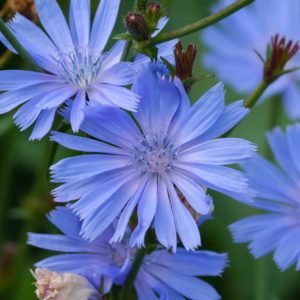
Chicory is something that you may have heard of in the context of flavouring (especially of tea and coffee, which is from the variety sativum), but you may not have recognised its wildflower cousin, cichorium intybus (common chicory) when you have seen it in the countryside. Found in many countries throughout the world as a native species, including Britain and parts of Europe, this wildflower is usually blue, though is occasionally pink or white, and is a member of the daisy family.
Where to see common chicory
Often found in meadows and hedgerows, the perennial chicory plant has a single stalk with numerous short offshoots, at the ends of which grow the flowers. When first emerging, the bright blue wildflowers’ petals are curved inwards lengthways, and look a little like very small bananas. After the petals unroll you can see that they have serrated tips, typically with five points to each tip; these are in fact five narrow petals fused together to form a single petal. When fully developed, the flower heads are about the same size as a dandelion flower, and they bloom between late spring and late autumn.
In the centre of the flower are dark blue and light blue striped anther tubes from which extend the stamen, which are split. The sepals from which the flowers sprout are green, hairy and have reddish tips. The leaves are narrow and pointed and covered in fine hairs.
Chicory for gardeners and beekeepers
Crucially for gardeners, cichorium intybus is featured on the RHS Perfect for Pollinators list. The RHS list is a great resource for anyone searching for wildflowers for their gardens or allotments that will attract fauna (especially bees, which we all know are struggling to thrive at the moment). The honeybee is particularly drawn to chicory, which makes this a great addition to any garden.
Chicory for medicinal use
Traditionally, chicory has been used in herbal medicine to treat a range of gastrointestinal ailments including gastroenteritis, gallstones and constipation; it has also been used to treat gout and jaundice. It is not recommended for consumption during pregnancy. The young leaves are often used in salads (though these are more palatable if blanched, as the raw leaves are rather bitter).
Growing chicory
Chicory is available as part of Turfonline’s range of wildflower-sown turf, perfect for adding to your garden as a natural border or as a wildflower feature. As part of a wide range of pre-seeded wildflowers within the turf, it will add a splash of blue to your garden and attract those bees, helping them to survive. The wildflowers included in Meadowmat turf feature on the RHS Perfect for Pollinators list and flower at various times during the year to maximise the bloom time within your garden, making them not only beautiful to look at and enjoy but also vital for the survival of many species of bees and pollinating insects.
Key facts about Chicory
- Height: 100-150cm
- Flowering Time: June – September
- Flower colour: Light blue
- Habitat: Grows best in open grasslands, roadsides and waste areas
Clustered Bellflower (Campanula Glomerata)
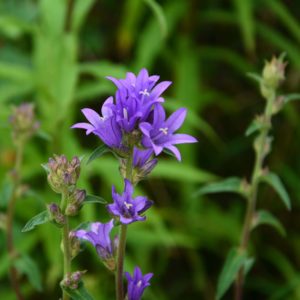

The Clustered Bellflower is an eye-catching wildflower native to south and east England, and the south of Scotland. This herbaceous perennial is also the county flower of Rutland, England, and Kincardineshire in Scotland. In Rutland, sightings of this majestic purple wildflower are quite rare, which only adds to its status as a treasured native species.
What does clustered bellflower look like?
The name Campanula glomerata perfectly describes this stunning purple wild flower, with “campanula” meaning small bell, and “glomerata” referring to the tight bundle of flowers at the top of the stem.
On summer days, these bright violet flowers can be seen craning upwards, held aloft by their eye-catching crimson stems. The individual flowers are between 2-3cm in size and cluster together in a tight bundle. The Campanula glomerata flowers between June and September – and sometimes as late as October – and provides a welcome injection of colour into any garden. Given its relatively short stature, coming in at just 20-60cm, it makes the perfect addition to the Meadowmat. It thrives equally well in the shade or in direct sunlight and being a hardy perennial, it will also fare well in a chalky or sandy soil.
Uses for Clustered bellflower
As the Clustered Bellflower features in the Meadowmat for Birds and Bees, you can guess that it’s going to be very popular with any little visitors to your garden. The clustered bellflower features on the RHS perfect for pollinators list, meaning you’ll be attracting bees to your garden in no time.
The Clustered Bellflower is a highly decorative flower which makes for quite the stunning display as part of the Meadowmat for Birds and Bees. In addition to being highly decorative, the leaves and flowers are also edible and make an interesting addition to summer salads. Although edible flowers might not be for everyone, the flowers can also be used as decoration in salads, or atop cakes and other desserts.
Some interesting folklore
In Cambridgeshire, the clustered bellflower was given a rather unfortunate nickname that would forever link it to thoughts of burial grounds and death. Wildflowers are often associated with graves and it was often said that they grow from the remains of the dead. In Cambridgeshire, it was thought that the crimson stem of the clustered bellflower was stained with the blood of Norsemen who were buried in the earth – and so it was named Dane’s Blood, a name which has stuck with it to this day.
Key facts about Clustered Bellflower
- Height: 10-50cm
- Flowering Time: May – July
- Flower colour: Violet
- Habitat: Grows best in dry chalky conditions. Often found in margins, banks, slopes and even cliffs.
Columbine (Aquilegia vulgaris)
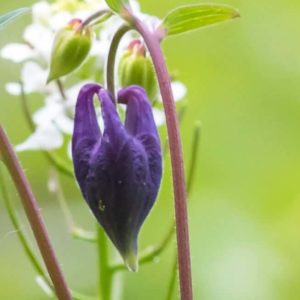

The purple wildflower common columbine grows up to 100cm tall and has bell-shaped flowers which bloom on long stems in early summer. When in flower, the plant is striking and can be seen from some distance away.
This wildflower grows all over the United Kingdom. The Latin name is Aquilegia vulgaris and it is also known as Granny’s Bonnet or the American Bluebell. Along the dark red or purple stems are three groups of three leaves.
This plant grows particularly well on fens, woodland areas, cottage gardens and damp places, but it has adapted to grow in domestic gardens as well.
The aquilegia is a member of the Ranunculaceae family and there are many different colour variations including blue, pink, yellow, white and purple. There are also delicate bi-coloured flowers which are really striking and a treat for the eyes. The British native species is the Aquilegia vulgaris and the flowers are usually purple, although there are some which have pink and white blooms. The bees love these flowers, in fact the columbine is on the RHS Perfect for Pollinators list of wildflowers. Grow these in your garden, and you’ll be helping the bee population expand and develop.
To make planting easy, choose a Meadowmat for cottage gardens and have a patch of colourful and charming wildflowers in no time at all.
Folklore surrounding Aquilegia
There are lots of tales and some folklore associated with Aquilegia vulgaris. The Latin name means ‘like an eagle’ and this comes from the talon-like spurs the flower produces. This plant has been associated with Freya, Norse goddess of love and fertility. She was later adopted by Christianity as well. The number of leaves, flowers and petals (3, 5 and 7) are also linked with the Holy Trinity. Shakespeare used the flower as well – Hamlet’s Ophelia gives a bouquet containing columbines to King Claudius, as a symbol of his infidelity.
Medicinal uses for Aquilegia or Columbine
The common columbine is edible and the purple wildflowers are used in salads and as a tea substitute. Often the plant is thought of as poisonous, but a large number of leaves must be consumed for there to be any ill affects. The plant is used in herbal medicine as a diuretic and as an astringent, but is not one of the commonly used plants. The seeds, when dried and crushed into a powder, can be used as a head lice treatment.
Key facts about Columbine
- Height: 50-100cm
- Flowering Time: May – July
- Flower colour: Blue, Pink or White
- Habitat: Grows best in damp conditions in woodlands, grasslands and fens.
Dandelion (Taraxacum Officinale)


The much maligned dandelion is actually a really pretty and robust flower. And who doesn’t love to see children puffing away at the fluffy seed-heads trying to tell the time.
Distinctive toothed leaves give the dandelion its name. Dandelion in French is dent de lion or “lion’s tooth”
Brightly coloured flowers sit atop hollow stems that contain a milky fluid. Seen enmasse they rarely fail to lift the spirits.
This is a perennial plant that readily seeds itself and needs very little care and attention.
Where to use Dandelions
Did you know that dandelion leaves are edible? Pick the young leaves (the older ones can taste quite bitter) to add to a salad.
If you hate mowing, nurture these plants in your lawn. The leaves stay green in the hottest of summers and these beauties with less grass you’ll be able to mow less frequently. The bees will thank you too!
Medicinally, dandelion is used in traditional medicine for the treatment of stomach and liver complains, as a diuretic and to relieve menstrual pains. Read more here, https://www.verywellhealth.com/the-benefits-of-dandelion-root-89103
Dandelions in Meadowmat
The dandelion is such a common plant on road verges and waste ground, that it gets taken for granted and thought of as a weed. The Meadowmat production team think that Dandelions are pure gold – and so do the pollinating insects that visit our fields.
We’ve included it in our low growing Species Rich Meadowmat for many many reasons. Here are just a few of them.
- Highly attractive to bees, hoverflies and other important pollinators
- Long flowering period means a reliable food source for insects
- Edible leaves – yum!
- Reliable and very easy to grow
- Bright pop of colour during summer months
- Happy to be mown
- Not too short and not too long …. A nice sized plant
Key facts about the Dandelion
- Height: 5-30cm
- Flowering Time: March – October
- Flower colour: Bright sunny yellow
- Habitat: Sunny places especially waste-ground, lawns and disturbed ground
Common Knapweed (Centaurea Nigra)
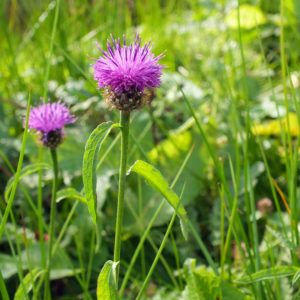

Description
Common knapweed Centaurea nigra, otherwise known as common knapweed or black knapweed, is part of the Asteraceae family and one of the most familiar floral sights in the UK. It’s also one of the 34 British native species of grasses and wild flowers you will find on your MeadowMat.
What does Common Knapweed look like?
Common knapweed is a wild flower similar in appearance to a thistle, with a vibrant purple crown that’s about 4cm wide. It’s a tall, branching plant that can grow up to 75cm. The ‘hard head’ of bracts underneath the flower head overlap each other like a pine cone; they’re mainly brown but the casual observer only sees the black bristly edges.
Common knapweed leaves are dull green with fine hairs and tend to have a narrow oblong shape with a point at both ends.
Where to see Common Knapweed
Common knapweed can be found all over the country on grassland, farmland, coastal areas, gardens, woodlands and heathland. It likes soil that’s low to moderately fertile, but the bright purple wild flower will not grow on land that’s very damp or acidic.
You’ll often spot it decorating roadside verges, cliff tops, field verges, wasteland and lawns.
When to plant Common Knapweed
As a perennial wildflower, common knapweed seeds can be planted at any time of the year and they will start to grow almost immediately. The flower heads are in bloom between June and September
A great plant for attracting and supporting wildlife
The Royal Horticultural Society has placed common knapweed on the RHS Perfect for Pollinators list in the medium grass height section (up to 50cm). This means it’s a good nectar and pollen provider for a variety of insects, including bees, butterflies, beetles and flies.
Some of the most likely types of butterfly you will see covering the flower head are common blues, marbled whites and meadow browns. After pollination Once the common knapweed has been pollinated it will attract birds that feed on its seeds, such as goldfinches. It will also attract other small birds that want to feed on the bugs taking nectar from the flower head.
Ancient and traditional uses for Common Knapweed
Traditional uses Common knapweed was historically used to treat flesh wounds, sore throats, bleeding gums and catarrh. Some physicians mixed it with other herbs to create antidotes for snake bites. The flower head is edible and when taken with pepper, it’s said to be a way of restoring lost appetite. Herbalists also still use the plant as a diuretic, tonic and means to induce sweating.
Key facts about Common Knapweed
- Height: 50-100cm
- Flowering Time: June – September
- Flower colour: Purple
- Habitat: It can often be found in grasslands, lawns, roadside verges and hedges.
Common Mallow (Malva sylvestris)
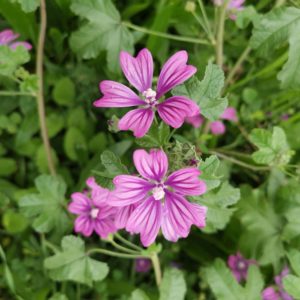

Common Mallow is a large spreading plant with stunning pale mauve flowers which can be found throughout the UK. It likes to grow on waste ground, roadside verges and in gardens. The flowers are funnel-like with five petals and with rounded leaves at the base and hairs on its stalk.
Uses for Common Mallow
Interestingly, the Common Mallow is a natural astringent, emollient and anti- inflammatory so it is used to soothe and soften skin. Did you know that the flowers, leaves and seeds of the Common Mallow are edible? It is believed that the Romans produced this plant specifically for medicine and food – it was very nutritious in recipes as it is packed with vitamins. It was also used to treat wounds, bruises, stings or insect bites, toothache, coughs and sore throats to name but a few.
Why grow Common Mallow?
- Easy to grow
- Not too fussy about soil type
- Bee friendly
- Butterfly friendly
- Use for therapeutic and medicinal purposes
Key facts about Common Mallow
- Height: 100 – 150cm
- Flowering time: June – October
- Flower colour: Pale Mauve
- Habitat: Grows in most soil conditions, however it seems to prefer sandy, dry soil and can be found across the globe
Common Mouse Ear (Cerastium Fontanum)
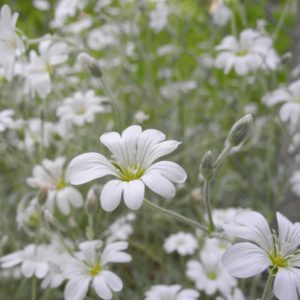

Tiny star-shaped white flowers shining out from the plant. Leaves are rounded and covered in short, downy hairs – just like the ears of a mouse! Stems are hairy too.
Each flower has 6-10, bright white petals with deep grooves at their edges that make them look like little white hearts.
Easily confused with chickweed.
Where to use Mouse-ear
Such a pretty little plant it would be a shame to take Mouse-ear for granted. Mouse-ear is regarded as an agricultural weed, but so are many of our beautiful garden plants such as cornflowers or poppies. Grown in the right place, this is a valuable addition to an outdoor space.
Pretty in pots, hanging baskets or borders. But we like Mouse-Ear as part of a species rich lawn. It’s low growing, reasonably tolerant of occasional mowing and attractive to pollinators. Not only that, Mouse-ear will dust your lawn with colour all through the summer.
Medicine and Folklore
Medicinally – be careful. Mouse-ear is edible and can make a healing tea to help relieve coughs and congestion BUT it looks quite similar to a plant named Euphorbia maculate which is poisonous. Make sure you know what you’re picking!
Traditionally Mouse-ear has been used to treat ladies who have miscarried. It’s also said to be helpful when battling cystitis. When cooked, it tastes like spinach – allegedly – and is highly nutritious. Don’t try eating it raw though – those little hairs on the leaves can really tickle your throat.
Common Poppy aka Field Poppy (Papaver Rhoeas)
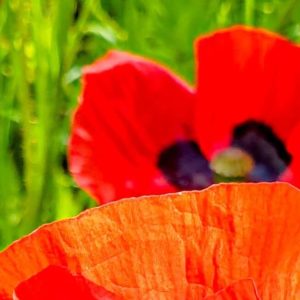

Possibly the easiest UK wildflower to recognise thanks to its association with the Royal British Legion and the annual Remembrance Day ceremonies held around the country.
Poppies are annual wildflowers, which means that they grow, flower, set seed and die all in the space of one year. Short-lived they may be but my goodness, they make the most of their time. Each plant can produce around 100 flowers in succession and their seeds are scattered hither and thither.
Flowers of course have bright red petals arranged in an open formation so that the black flower centres are very visible. Leaves are feathery and the seed pods are rounded with holes at the top like pepper pots. Once sown, the seeds lie dormant for decades until the soil is disturbed to stimulate germination
Uses for the Common Poppy
We humans have been using poppy seeds for thousands of years. They have been found mixed with grain in 2,500 year old Egyptian artefacts. The Romans and the Ancient Greeks used poppy extracts as a painkiller and to sooth upset tummies.
The alkaloids in red poppy are similar to those found in the opium poppy but not identical. They have a much weaker effect and are considered to be non-addictive
Poppy petals are used in herbal medicine to treat coughs and throat irritations.
In the kitchen, poppy seeds are perfectly edible and are delicious when sprinkled over bread and cakes or added to soups and stews. It is possible to press the seeds to extract the oil. This is a great substitute for olive oil in salad dressings and has a lovely nutty taste.
Poppies in Meadowmat
At Harrowden Turf we love poppies and hope that you do too. Although they prefer disturbed soil and may not appear in your Meadowmat after the first year, they add a great pop of colour while you wait for the perennial plants to establish.
- Stunning colour
- Looks great with long grasses
- Lengthy flowering period
- Reminiscent of cornfields before the introduction of herbicides
- Not fussy about soil type
Key facts about Common Poppies
- Height: 20-60cm
- Flowering Time: June – October
- Flower colour: Bright Red
- Habitat: cornfields, roadside verges, brownfield sites, disturbed ground
Common St John’s Wort (Hypericum Perforatum)
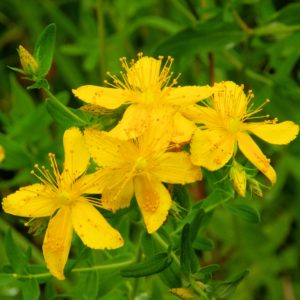

The Common St John’s Wort plant (scientific name Hypericum perforatum), a yellow wildflower, is a perennial plant which grows to between one and three feet tall. It thrives in many landscapes, including farmland, woodland, pastures and gardens. The plant can be found across Europe, where it is a native species, and further afield in Canada, the USA, Australia and South Africa.
Common St John’s Wort grows very easily; so much so it sometimes suffers a reputation for being a nuisance, noxious weed. It can also, in very large doses, be poisonous if consumed by livestock.
At Turfonline, however, we view Common St John’s Wort as a thriving wildflower, the RHS see it as a ‘Perfect for Pollinators’ plant and, with its bright yellow flowers which bloom during summer, it adds colour to a patch of wildflower meadow. It is also known for its many health-giving properties (more of which below).
How to grow and harvest Common St John’s Wort
Planted in spring, in mild temperatures and after the last frost, Common St John’s Wort is a hardy plant that will grow in most types of soil. It is a nectar source for pollinators so will provide both colour and a purpose during the summer months.
If you plan to harvest it, allow it to flower first. Bunch the stems together and hang in a cool, dry place, to let the leaves and flowers dry out – this process should take around two weeks. If you do decide to grow Common St John’s Wort, keep an eye on it, as it spreads quickly and can overwhelm other plants and herbs. One option is to grow it on its own in a pot or window box.
Traditional uses for Common St John’s Wort
St John’s Wort has been used for medicinal purposes since ancient Greek times; there is even a record of Hippocrates noting the benefit of the flowers.
Thanks to the chemical compounds present in the leaves of Common St John’s Wort, over the past few decades the plant has become recognised as an effective treatment for mild to moderate depression, as well as related conditions such as anxiety, tiredness, insomnia and loss of appetite.
An oil can be made from the flowers of Common St John’s Wort, which has anti-inflammatory qualities and is used to treat cuts, ulcers, wounds and muscle pain.
The flowers can also be used for a herbal tea that some people drink to treat bladder problems and diarrhoea.
Key facts about Common St John’s Wort
- Height: 50-100cm
- Flowering Time: June – August
- Flower colour: Yellow
- Habitat: can be found in meadows, valleys, hedgerows and riverbanks.
Common Sorrel (Rumex Acetosa)
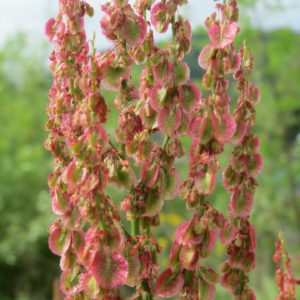

Common sorrel, or rumex acetosa, is a native species of wildflower found in the British Isles. A herbaceous perennial, it grows abundantly in all types of grassland, including hedgerows, meadows, cliffs, and roadsides.
Common sorrel grows as a single stem around a metre in height, from a shorter stem underground. Its leaves, which are bright green and flat, have two distinctive tips at the base that point downwards, distinguishing it from other docks. It has small, pale pink flowers that are unisexual, both male and female, although only one may be present per plant. These wild flowers grow in circles around the stem.
How to grow sorrel
The seeds are best sown in the spring months. They should be planted using a Meadowmat, or by placing the seeds six inches apart. By the summer the stalks will be tall and should be cut back to encourage the root to grow new leaves. Newer leaves are more tender and preferable for use with cooking or medicines. Common sorrel can be increased by splitting the roots and planting them about a foot apart and watering regularly.
Traditional uses for sorrel
Cultivated for centuries as a food plant, it is now mainly found and used by foragers and herbal medicine practitioners. Its leaves contain high levels of oxalic acid, giving the plant its distinctive acidic flavour that makes it great for flavouring soups or salads, or as an accompaniment for fish. Its leaves have cooling properties, making it a popular remedy for fever and other illnesses. It also has diuretic properties, which make it great for flushing out toxins and combating bloating. With a high vitamin C content, and substantial amounts of Vitamin A, Vitamin B1, B2 and B9, make it an effective treatment for scurvy.
Common sorrel has been credited with many other health benefits, including improving eyesight, increasing bone strength, fortifying the immune system, increasing circulation and energy levels, lowering blood pressure, and even preventing cancer. The root and seeds have astringent properties, and have been used to stem bleeding. The sap can be used a stain remover.
Common sorrel is sometimes ingested by wild and domesticated animals, which enjoy its acidic taste. Too much common sorrel can be dangerous to both humans and animals, due to its high levels of oxalic acid. However, the amount required to cause ill effect is fairly high, more than a bunch of leaves, which is unlikely to be consumed as a small amount is usually sufficient for flavouring and medicinal purposes.
Key facts about Common Sorrel
- Height: 50-100cm
- Flowering Time: May – August
- Flower colour: Reddish pink
- Habitat: can be found in open woodland, hedgerows, riverbanks and even mountain ledges.
Common Toadflax (Linaria Vulgaris)
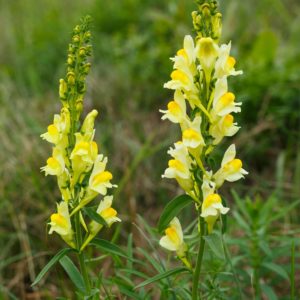

The common toadflax, is also known as yellow toadflax, the chilling ‘dead men’s bones’, and the descriptive, ‘butter and eggs’. The Latin name for this species of toadflax is Linaria vulgaris, with Linaria simply meaning toadflax, and vulgaris translating as common.
It is a wild perennial herb which is similar in appearance to the garden snapdragon, has a short, creeping root system, and several, erect and slender stems, reaching up to around a metre in height. These stems are rarely branched, instead featuring numerous long, narrow leaves, of a pale blue-green colouration, generally 2-6cm in length, and 1-5mm wide.
What Does Toadflax Look Like?
The yellow wildflowers of the common toadflax sit proudly atop the upright stems, with vibrant orange lower lips. These clustered flowers are normally between 2.5 and 3.5cm long and are almost always closed, with only strong insects, such as bumblebees able to pry their way inside. Above these flowers sit the fruit, a globose capsule of numerous seeds, approximately 5-11mm in length and half as broad.
The common toadflax adds real beauty to your Meadowmat. In contrast to its gentle beauty, the common toadflax is found commonly in nature in ruderal locations, such as roadsides, disturbed ground, and dunes, where it is able to establish itself on the sparsest of rubble. This plant is a native species of much of the Northern Hemisphere, from North America, throughout much of Europe, and as far East as Siberia and China.
The delicate-looking, but hardy common toadflax is present year-round in some form, but flowers from late June until October and the first signs of frost. This gives a splash of yellow wildflowers to your Meadowmat for over one-third of the year.
The Common Toadflax Is an Important Wildflower in the UK
The common toadflax attracts a huge array of fauna, including the aptly named Toadflax Pug Moth, the caterpillars of which, feed specifically on the seedpods and flowers. Other visiting moths include the mouse moth, satyr pug moth and the descriptively named, silver Y. Bumblebees and butterflies, including the small skipper, are attracted to this wild perennial, which in turn bring their predators, such as small birds and bats.
The common toadflax is widely held as possessing numerous medicinal properties, even though the oils contained within it are reported to be poisonous. Freshly picked toadflax has an unpleasant, peculiar odour, which is mostly removed upon drying. The plant may be useful for a variety of ailments, from jaundice to haemorrhoids, as well as being a potent emetic.
Key facts about Common Toadflax
- Height: 10-50cm
- Flowering Time: July – October
- Flower colour: Yellow
- Habitat: The plant is widespread on rural spots, along roads, in dunes, and on disturbed and cultivated land.
Common Vetch (Vicia Sativa)
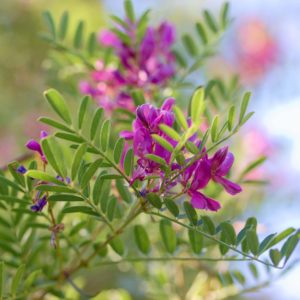

The common vetch (vicia sativa) is a native species of purple wildflower that flourishes in Britain and Europe. Also known as the ‘garden vetch’, it is a member of the pea family that grows up to 70 cm and flowers throughout June to August. It produces (as you might expect from a legume) long, hairy, dark green coloured seed pods that replace the dark purple flowers at the end of summer. The pod becomes smooth and black as it ripens before it splits and spreads the seeds inside.
Petals are shaped rather like butterflies resting on the stems; the flexible stems are long and can hold several flower heads, though typically this variety has three or four blooms per stem, a little like sweet peas. The leaves are narrow and oval, with short stalks, and several of them grow perpendicular to the stems all the way up from the base up to (and around) the flowers.
This pretty wildflower grows all over the countryside and is most often spotted in meadows, hedgerows and also on farmland; that is because as a nitrogen-fixer it is great for improving the quality and fertility of soil. Another benefit of this particular wildflower is that it is attractive to pollinating insects, bees, butterflies and moths (and, in turn, attracts a variety of garden birds).
Traditional uses for Common Vetch
Traditionally, the common vetch has been used as food for livestock and was also used in medicine to treat eczema and other skin irritations, and as an antiseptic. The seed pods can be eaten by humans, but it is important to correctly identify them as several other varieties look very similar but have seed pods that are inedible and poisonous.
The RHS Perfect for Pollinators list gives the names of the various flowers and plants that are known to attract pollinating insects. Vicia sativa’s cousin, Vicia faba (the broad bean) is listed, though Vicia sativa is not, possibly because it is a multi-petalled flower and as such would not be included in the list. However, it is known to be attractive to those visitors we would all like to encourage into our gardens, particularly knowing that the bee population is in trouble and needs all the help it can get.
Growing Common Vetch in your garden
A great way to introduce Vicia sativa into your garden is to consider buying it as part of a Meadowmat, which is a pre-planted turf roll full of a wide variety of wildflowers that have been specially chosen for their attractiveness to pollinators. The variety included in a Meadowmat has been designed to ensure a long flowering period (with different flowers blooming at different times of the year, and at different times of the day to attract as wide a range of insects as possible) and many different colours. The common vetch makes a pretty addition to any wildflower garden.
Key facts about Common Vetch
- Height: 50-100cm
- Flowering Time: June – September
- Flower colour: Pink
- Habitat: It grows well on farmland, waste ground, grassland and roadside verges. It can also be found in coastal areas such as sand dunes and rocks.
Corn Chamomile (Anthemis Arvensis)
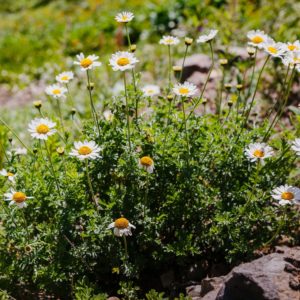

Cheerful daisy like flowers in summer time and pretty, feathery leaves. This is an annual plant that germinates, grows, flowers and fades all within a 12 month period. Nevertheless, it’s very easy on the eye and brings a bright pop of colour to the summer garden.
The plant does have a faint smell, but nowhere near as unpleasant as it’s cousin the stinking chamomile.
The centre of each flower is bright yellow and surrounded by many daisy like white petals. As the flower ages the petals lean backwards towards the stem.
Uses for Corn Chamomile
A valuable garden annual Corn chamomile sits just as happily in formal borders as it does in more relaxed prairie-style planting. You could even grow it in a potager garden. It looks spectacular grown alongside red-flowered runner bean plants.
Ecologists believe that these pretty plants were first brought to Britain from Europe in medieval times. Possibly as a medicinal herb. However, by the 1800’s the species was so successful that farmers thought of it as a weed. Today, modern farming practises have rendered the corn chamomile an endangered species.
Gardeners can help by growing Corn Chamomile as an ornamental plant.
Corn Chamomile in Meadowmat
We’ve added this jaunty plant to the seed-mix for Cottage Garden Meadowmat because it’s simply delightful.
Bright sprays of sparkling white flowers perfectly compliment the jewel like colours of the other species in this, our most garden-friendly type of Meadowmat.
What’s not to like about this annual wildflower?
- Very easy to grow
- Pollinator-friendly
- Eye-catching pop of colour
- Lovely fern-like foliage for extra interest
- Frost hardy
- Perfect for a cottage style garden
Key facts about Corn Chamomile
- Height: 20-50cm
- Flowering Time: June – September
- Flower colour: Sparkling white petals with yellow centres
- Habitat: Likes disturbed soil and full sun.
Cornflowers (Centaurea Cyanus)
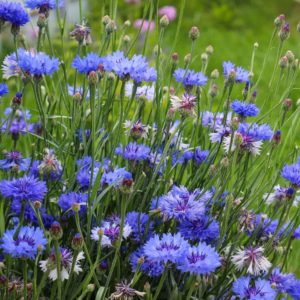

This once common cornfield annual is sadly quite rare in the wild which is a shame since it is one of our prettiest native wildflowers.
These are annual plants which means that they germinate, grow, flower, set seed and die within a 12 month period.
Bright blue flowers up to 3cm wide are held aloft on slender stems. Leaves are long, slender and pale green.
Where to use Cornflowers
Cornflowers never fail to raise a smile no matter where they are growing. In a planter, amongst cottage garden flowers, between rows of vegetables or as part of a wildflower meadow, cornflowers look amazing! Plus, they are very easy to grow.
Unsurprisingly, the juice can be extracted from the flowers and mixed with alum to make a watercolour paint.
Once dried, the flowers can be made into a medicinal tea. In historical times, such teas have been used to treat constipation, water retention and chest congestion. Apparently cornflower tea is also a good liver tonic.
For me though, I just want to see swathes of these flowers growing everywhere.
Cornflowers in Meadowmat
Most of the plants in the different types of Meadowmat are perennial but we simply couldn’t resist adding some cornflowers to our Birds and Bees, Cottage Garden and Heritage mixes just to add a bright pop of colour in the first summer.
Because it’s an annual, you’ll see fewer cornflowers in the second and subsequent years – unless of course, you harvest the seeds and sow them onto disturbed ground. Free seeds? Who can resist?
- Reliable and very easy to grow
- Bright pop of colour during summer months
- Attracts butterflies, bees and other pollinators
- Can be dead-headed to prolong the flowering period
- Perfect for any style of garden
Key facts about the beautiful Cornflower
- Height: 20-90cm
- Flowering Time: June – August
- Flower colour: Cornflower blue
- Habitat: Disturbed ground in full sun with light and sandy soil
Cosmos Albatross (Cosmos Bipinnatus Sensationa Albatross)
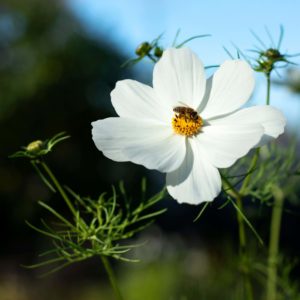

Beautiful white, almost transparent flowers that look beautiful in a moonlit garden. Feathery leaves, open, daisy like flowers that are very attractive to butterflies.
Likes moist soil and lots of sunshine. Cosmos Albatross is a hardy annual, which means that seeds sown in spring will grow fast and flower in summer time. However, the plants will die in autumn and not re-grow. Fortunately, cosmos is very good at self-seeding. Don’t be surprised to see young plants appearing as if by magic next spring.
Uses for Cosmos Albatross
A bewitching plant that draws the eye like no other. Grow in large swathes for a blast of clean white colour. Alternatively, when grown in combination with other flowering plants it gives a true cottage garden feel. Which is precisely why we’ve included it in the seed mix for Cottage Garden Meadowmat. Plus, we love watching the butterflies flock to it in high summer.
- Attracts butterflies
- Easy to grow
- Dead head regularly to prolong the flowering period
- Flowers all through summer and autumn – until the first frosts
- Very attractive flowers
Key facts about Cosmos Albatross
- Height: up to 150cm
- Flowering Time: July until the first frosts
- Flower colour: Pure White
- Habitat: Native to Mexico loves growing in sunny beds and borders in the UK
Cosmos Gloria (Cosmos bipinnatus ‘Gloria’)
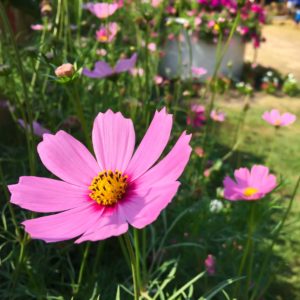

No wildlife garden is complete without a splattering of cosmos flowers. Delicate, paper thin petals form the classic flower shape. This flower looks exactly like the one that children like to draw. Cosmos Gloria has rose pink petals with a deep purple stain towards the centre of the flower. Stamens are bright yellow and the whole thing is elegant and jolly at the same time. Truly glorious!
Where to use Cosmos Gloria
Native to the Americas, Cosmos is also known as the Mexican Aster. It’s not frost hardy in the UK but is very good at self-seeding. One plant can produce several generations of these glorious flowers.
Beautiful in borders, these summer flowers also adapt well to meadow style plantings. Grow them with other flowering plants or with grasses. They look amazing either way. More importantly – butterflies, bees and other pollinators absolutely adore cosmos flowers. The pollen and nectar are easily accessible Plus, a long flowering period ensures a good food supply.
Deadhead regularly to encourage more flowers.
Key facts about Cosmos Gloria
- Height: Up to 90cm
- Flowering Time: June – September
- Flower colour: Rose pink
- Habitat: Full sun, garden plant loves neutral or slightly alkaline (chalky) soils
Cowslip (Primula Veris)


An evergreen or semi-evergreen plant, the cowslip flowers in the spring, producing small yellow flowers measuring around 10-15mm across. The blooms are produced in clusters of between 10 to 30 flowers to a single stem, with the plant itself growing to around 25cm tall and broad. Red or orange flowered cowslips are rare but can be widespread in small areas due to cross-pollination.
Conservation
One of the nation’s best-loved native species, the cowslip is making a resurgence after suffering a serious depletion in numbers during the 1970s. Changing agricultural practices in the 1970s and 80s put this little plant in jeopardy, but the inclusion of cowslip seeds in wildflower mixes, as well as in products such as Meadowmat, mean the plant is making a good comeback. Now the little yellow heads of the cowslip can be seen nodding on grass verges and motorway embankments the length and breadth of the country during April, May and June.
Pollination
The common cowslip features on the RHS Perfect for Pollinators list as a wildflower essential for supporting flying insects such as bees and hoverflies. As well as being a rich source of nectar, the flowers are also the larval host plant for the rare Duke of Burgundy butterfly. The larvae of this endangered butterfly feed on cowslips and primroses before transposing to winged adults in May and June.
Uses
The cowslip is greatly prized for its scent, which is not dissimilar to apricot, and is widely used in the perfume industry. Its pretty yellow flowers can also be used to produce cowslip wine.
Cowslips in culture
- The humble cowslip is the county flower of Northamptonshire, Surrey and Worcestershire.
- In the Victorian ‘language of flowers’ the cowslip was given to represent winning grace, youth, pensiveness, rusticity or healing.
- The ‘freckled cowslip’ appears in Shakespeare’s The Tempest as a symbol of a well-managed pasture.
- Strongly linked to English folklore, cowslip flowers are traditionally used to adorn May Day garlands, and for being strewn on church paths to celebrate weddings.
Key facts about Cowslip
- Height: 10-50cm
- Flowering Time: April – May
- Flower colour: Fragrant deep yellow
- Habitat: Often found in meadows, grassland and verges. They thrive on dry chalky soils.
Creeping Buttercup (Ranunculus Repens)
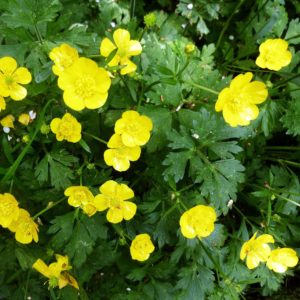

Any of the five species of buttercup found in the UK is like a splash of gold. Creeping buttercup is classed by some farmers as a weed but there can be no denying that the flowers are absolutely gorgeous.
Creeping buttercup, is a perennial plant which, as the name implies, spreads via runners. The leaves sit close to the ground and are hairy with three lobes and light spots. Each flower is 20-30mm across with 5 shiny yellow petals arranged into a wide, flat plate.
Uses for Creeping Buttercup
As a decorative plant, creeping buttercup is great. It’s undemanding, easy to care for and will soon fill in any bare spots.
Short-tongued bees are the main pollinators for creeping buttercup. They are able to reach the food with their tongue because the flower is open with a flat shape.
In a wildlife friendly lawn, Creeping Buttercup is a real asset. This pretty little plant tolerates mowing very well indeed and doesn’t mind being walked on. This beautiful flower is persistently colourful, no matter what the weather does and the bright yellow flowers never fail to lift the spirits. You’ll find Creeping Buttercup in the seedmix for our Species Rich Meadowmat lawn turf. The perfect way to bring more biodiversity and less work into your garden.
- Bright yellow flowers in the height of summer
- Pollinator friendly
- Self-sufficient plant needs no maintenance
- Frost hardy
- Perennial
- Tolerates mowing and foot traffic
Species Rich Meadowmat is for gardeners and estate managers who want low maintenance lawns with all year round interest.
Key facts about Creeping Buttercup
- Height: 10-50cm
- Flowering Time: May – August
- Flower colour: Sunny yellow
- Habitat: Typically found in disturbed habitats on damp, nutrient rich soils.
Common Daisy (Bellis Perennis)
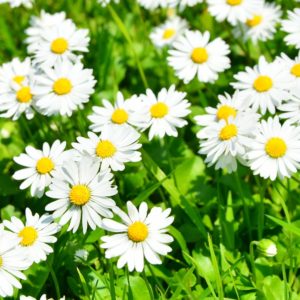

Is there any plant that embodies the English meadow better than the common daisy? With its cheery sun-yellow centre and soft white petals, this universally-recognisable wildflower is one of the most charming plants the UK has to offer. Most people assume that the common daisy’s flower head is a single flower. In reality, it is a composite (or Pseudanthium) comprised of multiple distinct flowers growing together to form a larger flower-like structure. This Pseudanthium can be seen from early summer to midsummer when the white wildflower is in bloom. The daisy has an exceptionally long blooming period and has even been known to produce flowers during winter if the weather is mild enough. In addition to its distinctive flower head, the common daisy can also be recognised by the rosette of rounded leaves that grows near its base.
Features of the common daisy
The common daisy belongs to the Asteraceae family and is technically known as the Bellis perennis. It is a native species of Europe and temperate Asian regions. Historically, it has also been called Bruisewort and woundwort. It is a long-lived perennial plant that gardeners can expect to see flower for several years in a row and it can reproduce itself easily by either seed distribution or by dividing after it has flowered. It’s not only easy to cultivate, but also very reliable; gardeners who invest in daisies can count on seeing their bright, joyous colours year in and year out.
The common daisy is also an especially hardy plant and will thrive in any reasonably well-drained soil, provided the ambient temperature is generally moderate. In the wild, it can be found in practically any area of grassland. Like the other plants available on our rolls of MeadowMat, the common daisy requires very little maintenance; you can leave it to grow on its own without worrying!
How do daisies help wildlife?
In addition to being gorgeous and hardy, the common daisy can also attract pollinating insects to your garden and the birds that feed on them. While the daisy doesn’t have a special relationship with one particular species of fauna, it can help improve the overall biodiversity of your garden.
Some uses for the common daisy plant
Interestingly, the common daisy has significant astringent properties – its juice will cause organic tissues to constrict if it is applied directly to them. Because of this, it was once used by Roman soldiers to soak bandages: when the bandages were applied, the daisy’s astringent properties would encourage wounds to close up and minimise blood lost.
The common daisy is an amazing plant with a rich history, and its addition to your garden will ensure a cheerful, easy-going vibe. We recommend it to any gardener looking to brighten up their life with an easy-to-cultivate wildflower.
Key facts about Common Daisy
- Height: up to 10cm
- Flowering Time: May – August
- Flower colour: White petals with a bright yellow centre
- Habitat: Daisies can thrive in both dry and wet conditions, sunny or shaded areas and therefor can be found everywhere from flat grassland to mountain tops.
Dames Violet (Hesperis matronalis)
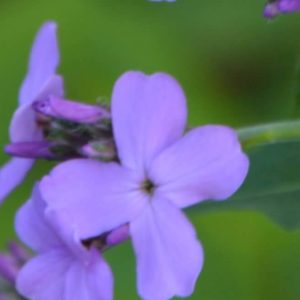

Dames violet is widespread throughout Britain and is a casual plant. It can be found in most habitats but you will most likely spot them on river banks, Hedgerows, roadsides and waste ground.
Uses of Dames Violet
It was traditionally used as a treatment of scurvy. The leaves of the plant have diuretic and sudorific properties which are used in medicine, due to their high content in vitamin C. The plant is cultivated for its essential oils, which is used in the perfume industry.
Key facts about Dames Violet
- Height: 50-100cm
- Flowering Time: June – August
- Flower colour: Fragrant Purple or White
- Habitat: Grows in moist and shady conditions, found in hedgerows, wasteland, woods, rivers and roads.
Erigeron Profusion
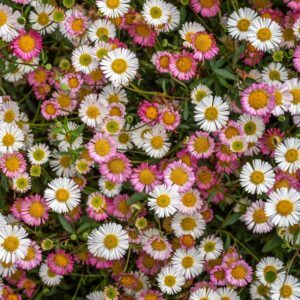

Erigeron (Mexican fleabane) is a slender plant native to Mexico. It has established itself in several Mediterranean and English gardens. It looks lovely creeping down the sides of stone or brick tucked in wall crevices. The plant seeds itself and also spreads slowly with its rhizomatous roots. Its one of those plants that will never look out of place, it’s great with almost anything!
Care
Erigeron Profusion is a very low maintenance plant that will cope with the occasional drought, it is recommended to cut any long stems back during the Autumn months.
Key facts about Erigeron Profusion
- Height: 10-50cm
- Flowering Time: May – November
- Flower colour: Opening white but turning to pinkish purple.
- Habitat: Grows in full sun and being drought tolerant means, you’ll often find this plant in coastal areas, rock gardens and gravel areas.
Fennel (Foeniculum vulgare)
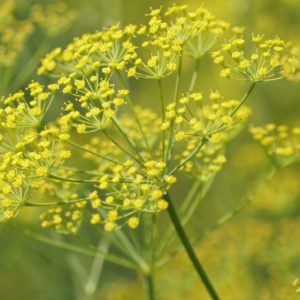

You should expect Fennel to die down naturally during the Autumn and re sprout during the spring, fennel will usually self-seed as the seed heads drop. Fennel leaves are very finely dissected, giving the foliage a very feathery appearance. Fennels bright yellow flowers are produced in a terminal compound umbel at the top of the stem. Each umbel section has 20–50 flowers on short pedicels. The flowers are very attractive to many beneficial insects including bees, small wasps, lacewings, and syrphid flies, as well as butterflies.
Culture
The Greek name for Fennel is marathon or marathos. Used as medicine, food and even insect repellent by the Greeks and Romans.
Uses
A flavourful herb that is widely used in cooking. With its similar anise taste its one of the primary ingredients in Absinthe.
When to see it
The best time to see Fennel is during July – October.
Key facts about Fennel
- Height: 150-250cm
- Flowering Time: July – October
- Flower colour: Small yellow.
- Habitat: You’ll often find this plant in coastal areas, rock gardens and gravel areas.
Field Scabious (Knautia Arvensis)
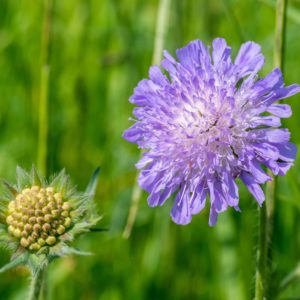

Description
Field Scabious (Knautia arvensis) is a blue wildflower (often appearing lilac in colour) which blooms between July and September. When fully grown, its height measures anywhere between 25 cm and 100 cm, depending on the drainage and nutrition within the soil. Commonly known as ‘lady’s pincushions’ or ‘blue bonnets’ thanks to the flower’s domed appearance, these are a common sight in British fields, chalky land and along the roadside. It is also known as the Gypsy Rose and is a native species to Britain and parts of Europe.
Each flower has a single cylindrical, long, green, stem with lots of fine, short white hairs. The few leaves are to be found at the base of the stems and are also hairy.
The flowers rather resemble marigolds (except for in colour, of course) and have concentric circles of petals that decrease in breadth towards the centre. In detail the outer petals are slightly scooped and towards the middle, the petals begin to roll inwards so that they are almost tube-like. Here and there appear the stamen: anther, which is dark purple, atop fine white filaments.
What Are the Traditional Uses of Field Scabious?
Traditionally, the field scabious wildflower was used to treat maladies of the skin including scabies (the Latin name comes from the word ‘scratch’) and itchy rashes. It was particularly popular as a remedy for skin irritations that were often experienced during the bubonic plague.
Field Scabious Is Popular in Wildlife
This is a very popular wildflower amongst our insect friends – it features on the RHS ‘Perfect for Pollinators’ list accordingly – and when in bloom, it will attract a wide range of bees, hoverflies, butterflies and moths. These pollinators are not only good for continued growth within your garden but are, of course, vital to the ecosystem and bees in particular need all the help they can get just now, as their numbers are in significant decline.
As a vital part of any wildflower meadow, the field scabious features in many of Turfonline’s products as part of their pre-planted turf rolls that can be laid directly onto gardens wherever you have some space. A natural wildflower border looks terrific surrounding a traditional lawn and looks equally beautiful as a natural feature in a corner of a garden plot.
Meadowmat And Field Scabious
Meadowmat turf rolls are carefully created to include a wide range of wildflowers that will bloom at different times of the year and at different times of the day, in a variety of colours to maximise the number and variety of insects that will visit. This innovative and easy-to-install idea aims to create areas of natural beauty wherever there is space to do so, to help boost native fauna and provide a lifeline to our ailing bees.
Key facts about Field Scabious
- Height: 100-150cm
- Flowering Time: June- October
- Flower colour: Blue-Lilac.
- Habitat: Popular in meadows, grass verges, hedgerows, railways and grassy wasteland.
Flax (Linum usitatissimum)
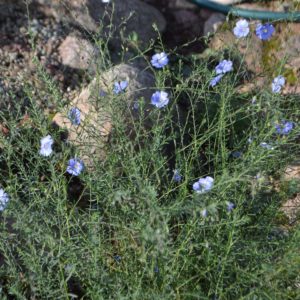

Flax is a pretty and very fast-growing plant, they are short lived but if they are in a sunny and sheltered area with well-draining soil then they will thrive.
Did you know?
It is cultivated as a food and fibre crop in regions of the world with temperate climates.
Key facts about Flax
- Height: 50-150cm
- Flowering Time: June- August
- Flower colour: usually blue in colour but sometimes white or pink.
- Habitat: The plant likes a variety of soils but grows best in well-drained sandy loam in warmer climates.
Fox and Cubs (Hieracium aurantiacum)
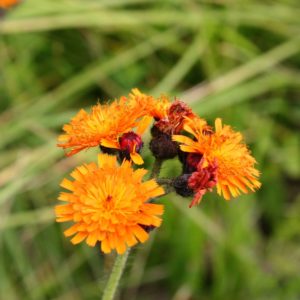

This is a bright orange wildflower that most people will know by sight but few will know by this name, though they might recognise the name ‘orange hawkweed’. The fox and cubs wildflower (Pilosella aurantiaca) is often treated as a weed in some parts of the world as it grows so prolifically once established, yet it is perfectly at home in a wildflower garden and plays a vital role in attracting pollinating insects. Gardeners interested in promoting a healthy population of pollinating insects often grow this orange wildflower specifically.
Fox And Cubs Are Perfect for Pollinating Insects
Named as one of the 400 ‘RHS perfect for pollinators’ wildflowers, the fox and cubs is a native species in Europe but was brought to Britain in the 17th Century, where it has flourished ever since. Growing up to 40cm it has a single tall, thin stem densely covered in dark hairs. At the top is a cluster of usually seven or eight flowers, each around 2cm in diameter with several distinct petals standing perpendicular to the stalk. It has large, broad leaves at its base, which are covered in long hairs.
Its bright orange colour is highly attractive to pollinating insects and it flowers from June to September, maximising the amount of time available for various species of bees and butterflies. The colour lends itself well to the common name, being not dissimilar to the fur of a fox, with the cubs being the many buds that grow beneath the blooming flowers ready to take their place.
How To Bring Fox and Cubs into Your Garden
The fox and cubs plant uses the wind to spread its seeds on parachutes similar to dandelion seeds, though they are smaller and not as fine as the latter. As a good source of nectar and pollen, it serves to attract honeybees and bumblebees and flies that in turn attract birds.
Best combined with other species of wildflower to attract as many pollinating insects as possible, you can install fox and cubs in your garden courtesy of a Meadowmat, which is a roll of turf containing wildflowers that are grown into a growing medium. This is more reliable than the alternative of sprinkling wildflower seeds and hoping for the best and provides a dense patch of meadow to any garden.
Its other names include the Devil’s Paintbrush and Grim the Collier (the latter after a 17th Century play of the same name). Unlike many other wildflowers, the fox and cubs plant has never been greatly used in traditional or herbal medicines.
Key facts about Fox and Cubs
- Height: 10-50cm
- Flowering Time: June – September
- Flower colour: orange – red.
- Habitat: Often found on stony waste land, churchyards, roadside, embankments and railway tracks.
Foxglove (Digitalis purpurea)
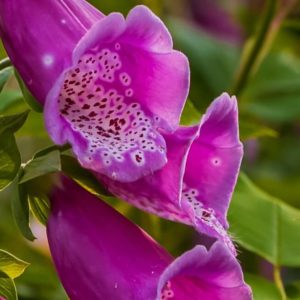

Description
Stately purple spires with tall flower spikes clothed in individual bell shaped flowers. Each foxglove flower is the perfect size for a foxes paw – hence the common name. The flower throat is pale and mottled with dark spots
Foxglove foliage forms a rosette close to the ground. Each leaf is up to 30cm long and shaped roughly like a flattened rugby ball.
Where to use Digitalis (Foxglove)
These flowers thrive in those cool, slightly shaded places in the garden. Beneath a deciduous tree, beside the shed or clothing a north facing bank. In the border, plant them in groups for a spectacular display or have them mingling with other wild flowers. Foxgloves, oxeye daisies and aquilegia look fabulous together especially when grown through feathery grasses such as tufted hair grass.
Foxglove is one of the few plants in any of our Meadowmat mixes that cannot be used for human consumption. Not ever. Not in any way, shape or form. It’s highly poisonous and can cause major problems. Having said that, bees absolutely adore it – and it’s a highly photogenic plant. In fact, if I were an artist, I’d have to include foxgloves in some, if not all of my work.
We’ve used in in both of our Birds and Bees mix because it does have such high wildlife value. So, provided you admire it from afar, foxglove is a valuable addition to any garden.
Key facts about Foxgloves
- Height: 60-200cm
- Flowering Time: June – August
- Flower colour: Purple
- Habitat: Light shade, open woods, woodland glades, riverbanks, waste land, railway embankments
Greater Knapweed (Centaurea scabiosa)


Greater Knapweed has large purple thistle. Found on dry, grasslands. It is most often associated with taller swards but can occasionally found in scrub land, woodland edges, road verges and waste ground.
Greater Knapweed is an important food source for a wide range of insects including bees and butterflies.
Key facts about Greater Knapweed
- Height: 50-100cm
- Flowering Time: June – September
- Flower colour: Purple
- Habitat: Found growing in dry grasslands, hedgerows and cliffs on lime-rich soils.
Harebell (Campanula Rotundifolia)
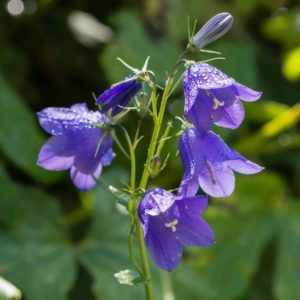

The delicate nodding heads of the harebell do indeed look just like a bell. This plant is a member of the campanula family along with the clustered bellflower and the nettle leaved bellflower
This low growing herb has an erect growing habit, slender stems and rounded basal leaves. Sadly it seems to be rapidly disappearing from our countryside. Gardeners of the UK – we need to do what we can to preserve this gorgeous plant.
Where to use Harebells
Medicinally
Chewing the root of the harebell has traditionally been used in the treatment of heart and lung problems. Ancient herbalists would also make an infusion of the plant to use as a wash for sore eyes.
Culturally
This stunning little plant has inspired many a writer. In this poem, entitled “Hope is Like a Harebell” Christina Rossetti (1830-1894) likens the harebell’s delicate features to the emotion of hope.
Hope is like a harebell, trembling from its birth,
Love is like a rose, the joy of all the earth,
Faith is like a lily, lifted high and white,
Love is like a lovely rose, the world’s delight.
Harebells and sweet lilies show a thornless growth,
But the rose with all its thorns excels them both
Folklore
Looking at the harebell you would never imagine it to be associated with witches, faeries and the devil – but it is! (or rather it was)
The plant probably earned its name by being found in the same places that hares are found. And, as we all know, witches turn themselves into hares when they’re heading out to steal milk from cows. Curiously enough, the harebell does have a milky white sap in its stem.
Growing Harebells in the garden
We’ve included harebells in Meadowmat for Birds and Bees simply because we love the colour, the delicacy and the fact that it’s flowering when many other wildflower species are out of season.
If you’ve not tried growing wildflowers with Meadowmat before, its probably one of the easiest ways to establish a colourful and wildlife friendly space.
Key facts about the Harebell
- Height: 10-50cm
- Flowering Time: July – September
- Flower colour: delicate blue
- Habitat: Dry, infertile soils on undisturbed grounds. Typically heaths, dunes, downland and hillsides
Hay Rattle (Rhinanthus Minor)
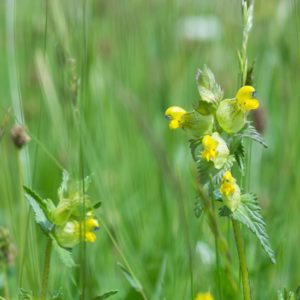

Hay rattle (also known as Yellow Rattle) is an attractive, yellow wild flower with toothed leaves, whose papery seed pods rattle, hence the name.
A native species in many Northern European countries, hay rattle is one of the quintessential wild flowers found in fields and meadows during the summer months. In optimum conditions, hay rattle – sometimes called yellow rattle or corn rattle – will spread rapidly. This can be due to mechanical means, for example seeds being carried by farming machinery or within hay crops.
Hay rattle is a favoured plant for people creating wildflower meadows; it is one of the fastest growing of all wild flowers, and will produce a colourful, lush meadow in next to no time. Hay rattle, which generally flowers from May to July, is a prize species for wildlife enthusiasts because of its strong growth properties, and because it promotes bio diversity in meadows and fields.
So while some farmers and gardeners dislike hay rattle due to its vigorous growth and the fact it is semi-parasitic (meaning it steals nutrients from other plants), it is the perfect choice if you want variety in your garden or meadow. This is because hay rattle stems the growth of aggressive grasses so that other plants and wild flowers can thrive, such as red campion, lady’s bedstraw and common St John’s wort; wild flowers named by the RHS as perfect pollinators, their nectar attracting butterflies and bees that in turn provide vital support for our fragile ecosystem.
Growing and harvesting Hay rattle’s large seeds allow the plant to produce strong seedlings that germinate very early in the year, giving plenty of opportunity for you to plant these seedlings and start the cycle for the next season. Alternatively, you can keep things simple and invest in a Meadowmat, a pre-grown wildflower meadow that’s as easy to lay as lawn turf.
Traditional uses for Hay rattle
Hay rattle is very pretty and admired for its aesthetic qualities. However, it also does an excellent job of weakening and reducing aggressive grass growth, which often provides stiff competition for wild flowers in open lawns and meadows. By stemming this spread, other species have a chance to grow and thrive.
Key facts about Hay Rattle
- Height: 10-50cm
- Flowering Time: May – July
- Flower colour: Yellow
- Habitat: Dry fields, meadows and dunes. It tolerates a variety of different soil types.
Kidney Vetch (Anthyllis vulneraria)
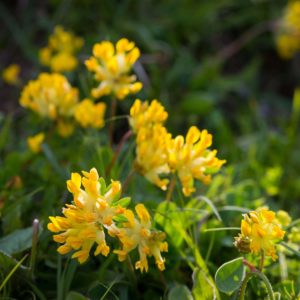

Kidney vetch is easy recognisable as it has clusters of yellow flowers with little woolly flowers like cushions. It is common in chalk grassland across the Uk. Kidney vetch is known for its unusual flower heads as they are in two parts. One side will be coming into bloom while the other has semi-ripened seeds.
Perfect for Wildlife
Kidney vetch provides food for a number of beetles and moth larvae but, most importantly, is the sole food plant for the caterpillars of the small blue butterfly. The flowers also provide nectar and pollen for beetles and bees.
Key facts about Kidney Vetch
- Height: 10-50cm
- Flowering Time: June – September
- Flower colour: Yellow
- Habitat: You’ll find it growing on Sand Dunes, chalk grasslands and even cliffs.
Lady’s Bedstraw (Galium Verum)


Lady’s Bedstraw (or Galium Verum) is a perennial plant and a native species throughout Europe, North Africa, and parts of Asia. The bright yellow flowers of lady’s bedstraw, sometimes known as yellow bedstraw, can be spotted all over the UK during July and August, and also recognised by its sweet scent. Found in several habitats including meadows, heathlands, grasslands and in sandy coastal areas, lady’s bedstraw is thought to be so-called because its dried flowers were traditionally used for stuffing straw mattresses, often for pregnant women, as the coumarin scent kills fleas and the plant was thought to aid a safe delivery.
Lady’s bedstraw is a popular proponent in wildflower meadows and is also named by the Royal Horticultural Society (RHS) as ‘perfect for pollinators’: it provides a rich sources of nectar for pollinating insects such as bumble bees and butterflies. It also provides food for caterpillars.
Growing and harvesting Lady’s Bedstraw
Lady’s bedstraw loves bright sunshine and dry soil. It is an invasive plant, regarded by some to be a nuisance weed. But its fast-growing properties and colour make it a great wild flower; just be sure to plant it where it won’t be a problem when it spreads. To promote its spreading, divide the plants in spring or early autumn. To contain its spreading, use a pot or a hoop.
Alternatively, you can make thing easy for yourself and invest in Meadowmat, a pre-grown wildflower meadow that’s as simple to lay as lawn turf. Meadowmat and organisations such as the RHS can provide further advice and tips about what and how to plant this yellow wild flower.
Traditional uses of Lady’s bedstraw
Lady’s bedstraw has many uses. At one time it was used as a remedy for urinary infections, gout and epilepsy. The leaves and stems contain an enzyme that curdles milk, and for centuries they have been used for this purpose, in place of rennet. In the 16th century it was even called ‘cheese renning’ and is these days sometimes known as cheese rennet.
Lady’s bedstraw also sweetens milk and colours cheese – at one time the plant gave Cheddar cheeses and double Gloucester their colour, before ingredients such as annatto became popular.
The plant is used for red and yellow dyes: red dye from the roots, and yellow dye from the flowers. The dye is used today by people in the crafts and arts industries, and also in the Danish alcoholic drink, bjæsk.
Key facts about Lady’s bedstraw
- Height: 10-50cm
- Flowering Time: July – August
- Flower colour: Yellow
- Habitat: Popular in meadows, on road verges, cliff tops, hedges, dunes and other grassy areas.
Linaria – Northern Lights (Linaria maroccana)
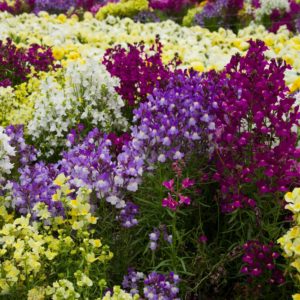

Linaria will attract bees, beneficial insects, butterflies/moths and other pollinators. It has nectar/pollen rich flowers.
Key facts about Linaria
- Height: 10-50cm
- Flowering Time: July – August
- Flower colour: Yellow
- Habitat: A decorative flower often found in City and courtyard gardens, cottage gardens, wildlife gardens, cut flowers
Maiden Pink (Dianthus Deltoides)
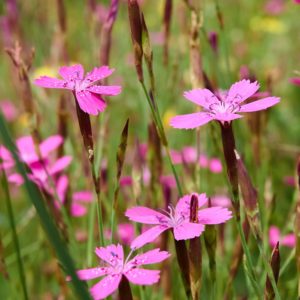

The maiden pink, or Dianthus Deltoides, is a pretty, evergreen wildflower which covers the ground with a low matting that looks attractive all year round. These plants are excellent to use when creating a cottage garden as they are bright and long-flowering. The plants grow roughly 10 to 20cm tall on a slender stem, and when there are several flowering plants in a tuft, they look very striking indeed.
This cheerful pink wildflower is a British native species and can be found in most parts of England and Wales, and some parts of southern Scotland. The Maiden Pink grows on stony ground, on hillsides, beside roads and in meadows and is able to survive prolonged dry periods. For these reasons, it is often used in garden rockeries and in hilly places where the moisture in the soil is quite low.
What do Maiden Pink flowers look like?
Showy enough to cheer up any area of the garden, Maiden Pinks have hot pink flowers which seem to endlessly bloom from June to September. A member of the Caryophyllaceae family, the maiden pink gets its common name from the jagged edges of the delicate petals produced – they look as if they have been cut with ‘pinking sheers’.
It’s possible to display these plants indoors in a vase or a jam jar and use them as cut flowers for an informal setting. Its attractive nature suggests that it would have a strong perfume, but in fact it has no fragrance at all.
Plants for butterflies and bees
The maiden pink plant is very attractive to butterflies and these insects are the main pollinators, although the occasional bee and hoverfly may also visit. Dianthus deltoides are self seeding and if the plants are sheered after the seeds have formed, new plants can grow in moist conditions. The greyish green leaves are stalkless and form on slender stems. These leaves stay green all year around, so any Meadowmat with this in it will look lush and dense, even in the winter months.
The Maiden Pink blends in beautifully with other meadow plants that are on the RHS Perfect for Pollinators list, and when grown alongside wildflowers that attract a lot of bees, the wildlife that will visit will be diverse and healthy.
A little known fact about the Maiden Pink: it is the county flower for Roxburghshire in Scotland.
Key facts about Maiden Pink
- Height: 10-50cm
- Flowering Time: June – September
- Flower colour: Pink flecked with darker or paler spots
- Habitat: This plant grows on dry grassland, meadows, stony hillside ridges, banks and roadsides.
Meadow Buttercup (Ranunculus acris)
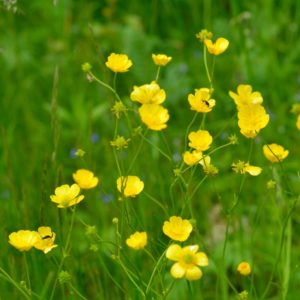

Most people can recognise members of the buttercup family but telling one from another is quite an art. Meadow buttercup of course has the distinctive bright yellow flowers that you’d expect. It has smooth, hairless stems that branch to hold several nodding heads on each plant. This is the tallest buttercup in the UK.
Where to use Meadow Buttercup
It’s not by accident that Meadow Buttercup pops up in the species list for most of types of Meadowmat. It’s an extremely versatile little plant with a happy disposition that brings a smile to any face – even on an overcast day. As its name suggests, this particular wildflower has adapted itself to the lifecycle of the meadow. Meadow Buttercup likes being mown in summer and then being left more or less undisturbed for the rest of the year.
Interestingly, the leaves and flowers of Meadow Buttercup taste bitter to protect them from being eaten alive by cattle, sheep or horses. Once cut and dried however, the plant is more palatable and farmers are quite happy for it to appear in a hay crop.
There are lots of medicinal uses for Meadow Buttercup but be careful – as with most medicines it can be quite toxic. When crushed the leaves and flowers make an excellent poultice. Apply it to the chest to relieve a cold or pop it onto wounds to ward off infection. Tibetan herbalists use Meadow Buttercup to treat tumors. Fresh leaves can be used as a rubefacient to help treat rheumatism (rubefacient increases blood flow to an area and creates warmth).
Key facts about Meadow Buttercup
- Height: 50-100cm
- Flowering Time: April – October
- Flower colour: Bright Yellow
- Habitat: Unimproved hay meadows and water meadows, also dune grasslands, mountainsides and rock ledges
Meadow Cranesbill (Geranium Pratense)
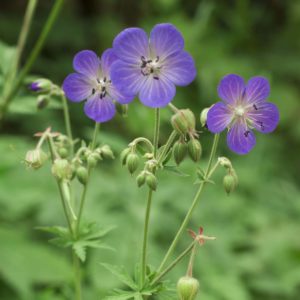

Description
Meadow Cranesbill (Geranium Pratense) is a beautiful, purple-blue wildflower that is commonly seen in meadows, along roadsides and hedgerows, and particularly in areas where soil is chalky and well drained. It is a perennial, native species within the British Isles and Europe and typically flowers between June and August each year.
A member of the geranium family, it grows up to around 75 cm and features five large petals, which taper to points at the tips. Each petal is threaded with pale veins and around the prominent white stigma in the centre are ten stamen, which consist of pale purple filaments and dark purple anther. The flower heads measure 3 – 4 cm across and the seed pods look a little like birds’ bills, hence the common name for them.
Meadow Cranesbill grows in clumps, forming small bushes that are covered in divided leaves and dotted with flowers. The leaves splay out like a rosette, at around 5 – 6 cm in diameter, and have five to seven lobes: they are tapered, short-stalked and large toothed.
According to folklore, Meadow Cranesbill was the flower to turn to if you wanted to cure or treat cholera, dysentery, diarrhoea, haemorrhoids and nosebleeds.
Using Meadow Cranesbill to support wildlife
The RHS Perfect for Pollinators list includes Meadow Cranesbill because it is so attractive to bees, butterflies and other pollinating insects. The list has been created to help anyone who has some outdoor space at their disposal (whether that is a large garden or a window box) to grow plants and flowers that will encourage pollinators to visit. This is becoming increasingly important in Britain and across the world as the global bee population is in serious decline and this has wide implications for the ecosystem. The Perfect for Pollinators list contains the names of the plants and flowers that are most attractive to bees and insects. Meadow Cranesbill is particularly attractive to all sorts of bees.
Of course, when insects are attracted to a garden, birds will follow, so planting a wildflower garden can also increase the number and variety of birds that will visit.
Turfonline has sourced and pre-planted numerous types of wildflowers that feature on the list (including Meadow Cranesbill) to create their wildflower rolls, which can be planted in any garden as long as the ground is not flooded or frozen. They are easy to grow and require minimal maintenance, and are a simple way to make a garden beautiful and also to encourage pollinating insects to visit. Those insects will benefit the entire garden and our Meadowmat features a wide variety of wildflowers to maximise the amount of colour in your garden and time throughout the year when the flowers will bloom.
Key facts about Meadow Cranesbill
- Height: 50-100cm
- Flowering Time: June – September
- Flower colour: Bright Blue
- Habitat: Found in hay meadows, roadside verges and grasslands. It particularly likes chalky soils.
Meadow Saxifrage (Saxifraga granulata)
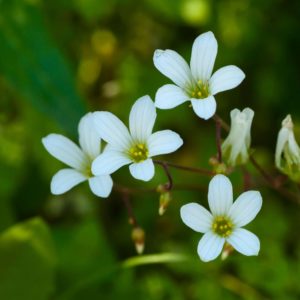

Looking very much as though it belongs in a rockery but actually a lowland plant, Meadow saxifrage is one of the prettiest plants I know. Kidney shaped leaves site close to the ground. Every spring, this lovely little plant pops up a single, straight stem. Every stem is topped by up to twelve, star shaped white flowers. Seen en masse – there’s nothing lovelier.
The flowers are a mere 1-2cm wide and each one is made up of five round petals. Each petal is joined to a deep, green-veined cup from where the golden yellow stamens emerge. This plant is a close relative of Londonpride, a classic cottage garden plant.
Look closely at the base of the stems. You’ll see a little nut-coloured bulbil. This is what the plant uses to reproduce. Break off the bulb and you can use it to start a new plant.
I’ve read that this means of reproduction allowed Meadow saxifrage to colonise a small part of Finland. The bulbils were accidentally transported there in the soil used for ships ballast.
Where to use Meadow Saxifrage
This is a classic cottage garden plant that absolutely loves living amongst sedums on an extensive green roof.
As with many plants, there’s a clue to its use within the scientific name. Saxifraga means “rock breaker” whilst “granulate” means “with grain”. Medicinally, the bulbils of this plant can be used to help disperse kidney stones. Another school of thought is that “Saxifraga” refers to the species’ ability to live in thin, stony soils.
Meadow Saxifrage for Green Roofs
Flowering earlier in the year than most sedums, Saxifraga granulata is a great green roof plant. The nodding white flowers bring joy to an otherwise boring vista and truly welcome spring.
Meadow Saxifrage for gardens
A beautiful plant for an alpine trough or planted en masse, Saxifraga granulate is also a welcome addition to borders or to wildflower areas. Flowering after snowdrops but before the main flush of garden blooms, it’s a great “filler”.
Key facts about Meadow Saxifrage
- Height: 10-50cm
- Flowering Time: April – June
- Flower colour: White
- Habitat: Moist but well drained soils, sunshine or light shade.
Meadow Vetchling (Lathyrus Pratensis)
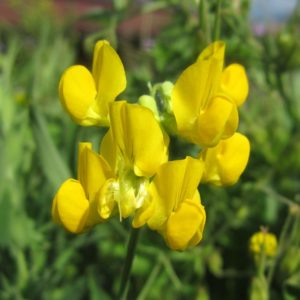

It would be very easy to mistake this plant for Birdsfoot Trefoil. The bright yellow flowers are a similar shape and equally attractive to bees. However, this is more of a scrambling plant than it’s lookalike. In fact, Meadow vetchling is closely related to the sweet peas that you might be growing in your garden this year.
A perennial herb – in other words it dies back in autumn and regrows in spring – Meadow Vetchling is one of the first wildflowers you’ll see after the primroses et al have finished blooming. It’s name, Vetchling implies (quite rightly) that it’s a small vetch. The leaves have tendrils which help them to climb through bushes and cling onto other plants for support.
Flowers are a glorious shade of yellow and appear in groups of between five and twelve on long stems. Very similar flowers to peas and vetches. The seed pods are like tiny pea pods around 20mm and turning black when ripe.
Uses for Meadow Vetchling
Meadow Vetchling is one plant that farmers welcome in their hay meadows. It is a legume – meaning that little nodules on the roots actively enrich the soil. It’s also really protein rich and cattle love munching on it.
It is said that Meadow Vetchling plants will repel mice – I’ve not tested the theory yet but it has to be worth a try.
Meadow Vetchling in Meadowmat
We’ve included Birdsfoot Trefoil in Meadowmat for Woodland Shade for lots of good reasons
- Brightly coloured to bring pizzazz to a slightly shaded area
- Improves soil nutrient levels – helps to feed other plants
- Easy to grow
- Bee friendly
- Low growing
- Not too fussy about soil type
- Frost hardy
- Perennial
Key facts about Meadow Vetchling
- Height: 50-100 cm
- Flowering Time: May – August
- Flower colour: Yellow
- Habitat: Pasture, road verges, hedgerows
Meadowsweet (Filipendula Ulmaria)
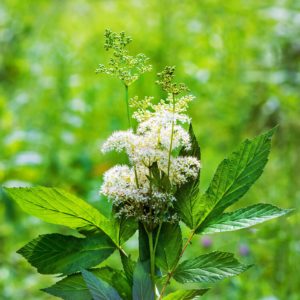

Meadowsweet, also known as mead wort and bride wort, is a wild, perennial herbaceous plant. Its Latin name, Filipendula Ulmaria, relates to it being of the genus Filipendula, a genus of twelve species of herbaceous, flowering plants that are native to the Northern Hemisphere. Ulmaria comes from the leaves bearing a resemblance to that of the elm tree.
What does Meadowsweet look like?
The stem of the Meadowsweet generally reaches between one and two metres in height, is furrowed and angular in appearance, and red to purple in colour. Its elm-like leaves have dark green uppers, and downy, paler undersides. The terminal leaflets of the Meadowsweet are fairly large at 4-8cm in length, and commonly contain between three and five lobes. The white wild flowers of this plant are closely clustered and have a very strong, sweet fragrance.
The Meadowsweet is a wild, native species to most of Europe and Western Asia, as well as Eastern parts of the USA and areas of Canada. This plant will add height to your Meadowmat, and is most commonly found in the wild in damp meadows, particularly in ditches and bogs, on river banks, and at the edges of ponds and lakes.
Meadowsweet is a hardy plant that can brave the harshest conditions that the temperate climates in which it resides can throw at it. It survives relatively unscathed all year round, with it’s greatest enemy being drought.
The graceful wildflowers generally appear from early June to September, brightening up the marshlands and riverbanks. A common addition to the meadowsweet is the aptly named meadowsweet rust gall, a bright, rusty orange fungus that is transferred via the air and generally attaches to the undersides of the leaves, as well as the stalks. This, although striking to look at, causes some swelling and reduces the survival rate of seedlings.
Meadowsweet, a good plant for wildlife gardeners
Meadowsweet is known for attracting an array of fauna. Bees are particularly fond of this plant’s sweet, inviting aromas. Butterflies and moths are also regular visitors, bringing along their predators, such as small birds and bats.
Traditional uses of Meadowsweet
Possibly the most fascinating thing about meadowsweet is its many uses as a medicine and tonic. Known to have been one of the plants held as sacred by the ancient druids, the meadowsweet has a wide range of purported medicinal uses. These include use as a diuretic, as an anti-inflammatory, as a supportive therapy for the common cold, and it is thought to be particularly useful for easing symptoms of arthritis.
Key facts about Meadowsweet
- Height: 50-100 cm
- Flowering Time: June – September
- Flower colour: Cream
- Habitat: Flourishes in damp soils in grasslands and heathlands.
Melton Pastels (Knautia Melton)
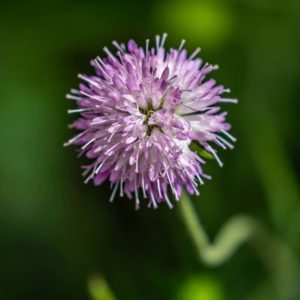

Sometimes referred to as the Macedonian Scabious,’ Knautia Melton’ Pastels is a delicate perennial. Melton Pastels will self-seed in the autumn.
When to see
Flowering over a long period from July right through to October
Key facts about Melton Pastels
- Height: 50-100 cm
- Flowering Time: July – October
- Flower colour: Mauve to pink to red
- Habitat: A pretty flower that looks great in pots on a patio, cottage gardens, flower beds and even as a cut flower.
Musk Mallow (Malva Moschata)
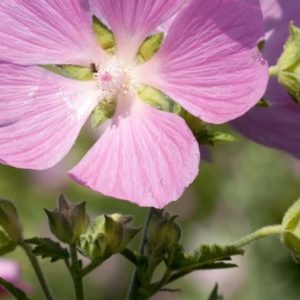

Malva moschata (commonly known as musk mallow) is a pink wildflower cultivated for its striking scented flowers that flourish through the summer months. Musk mallow variations include the ‘Rosea’, which has flowers with deep pink shade, and the ‘Alba’, which has white flowers.
Where Did Musk Mallow Originate?
Musk mallow is a native species to large parts of Eurasia. The flower appears as far west as Spain and as far east as Turkey and parts of Southern Russia. Malva moschata has been successfully cultivated in other temperate regions such as North America and New Zealand. This broad range of climates demonstrates that this plant can be grown perennially and is most suited to temperate climates from sea level up to 1,500 m. Rich soil dense in nutrients is preferred by the plant, and it tends to grow in open grasslands with good exposure to sunlight.
When Does Musk Mallow Flower?
The plant flowers through July and August producing five-petalled, open funnel-shaped flowers. These flowers, when fully grown, will reach 3.2 – 5 cm in diameter. At maturity, the plant will reach, at maximum, 80 cm high. If you inspect the plant closely, you will also see that the stems have small hairs growing away from the soil. Leaves are 2 – 8 cm long and 2 – 8 cm in width, with five to seven lobes in a palmately lobed pattern. The leaves of the flower stem retain shallow lobes whilst the leaves higher up the stem are divided with narrow, acuminate lobes.
Which Other Wildflowers Does Musk Mallow Grow Well With?
The musk mallow mixes with other annuals such as poppy or chamomile but also grows well with other flowers typically found in perennial meadows, such as oxeye daisies, field scabious, and knapweed. Malva moschata also features on the RHS Perfect for Pollinators list, as bees and other insects will frequently visit the flowers for nectar and pollen. Its ability to attract wildlife makes it an important element of our Meadowmat products.
Musk Mallow Works Great in Meadowmat for Birds and Bees
The plant is traditionally grown as an ornamental feature of country gardens. The flowers produce a delicate but dusky perfume in warmer weather, which makes them a popular choice for gardeners.
Musk mallow has a range of medicinal and culinary purposes. Both the seeds and flowers are edible, and the family of mallow plants has been used as an addition to salads and other light meals for centuries. In ancient societies, the musk mallow was thought to reduce inflammation and irritation of the digestive system.
Key facts about Musk Mallow
- Height: 50-100 cm
- Flowering Time: July – August
- Flower colour: Rose Pink
- Habitat: It grows on dry field edges and roadside verges, churchyards and pastures.
Nettle Leaved Bellflower (Campanula Trachelium)
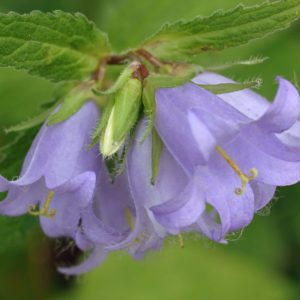

A cottage garden favourite and popular with bumblebees who adore the bell shaped flowers. Leaves, as the name suggests, are bristly and heart shaped with toothed edges – just like a stinging nettle.
Several flowers appear on each stem and are spaced along its length. Top flowers open first (unlike the giant bellflower whose lower flowers are the first to open)
The flowers themselves are a bluish, purple grey colour, 25-35mm long and with a nice wide entrance to welome visiting bees.
Uses for Nettle Leaved Bellflower
The alternative name for Campanula trachelium is “Throatwort”. “Trachelium” refers to its ancient medicinal use as a throat medicine.
Other names include “Our Lady’s Bells” because the blue flowers are reminiscent of the Virgin Mary’s headscarf. “Coventry Bells” – because this plant was especially common around the Midlands town of Coventry. And “Bats in the Belfry” because the stamens look like little bats hanging upside down in a church belltower.
Nettle Leaved Bellflower is also one of 30+ species of wildflower in our Cottage Garden Meadowmat. Why was it included? Well, for lots of reasons
- Tall, showy flower spikes in the height of summer
- Easy to grow and not susceptible to disease
- Delicate colour
- Attractive to bumblebees
- Low maintenance and easy to care for
- Frost hardy
- Perennial
Cottage Garden Meadowmat is just the ticket for gardeners who want the enjoy all of the benefits of a wildflower area but are aiming at a more cultivated look.
Key facts about Nettle Leaved Bellflower
- Height: 50-80cm
- Flowering Time: June – September
- Flower colour: purple-blue
- Habitat: Likes chalky soils in woodland, grassland and hedge banks. Prefers light shade
Oxeye Daisy (Leucanthemum Vulgare)
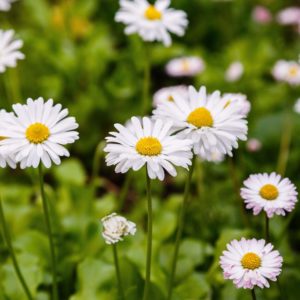

The oxeye daisy (Leucanthemum vulgare) is a familiar sight along British motorway verges and on grassy roundabouts. It has many other names, including the dog daisy, field daisy and moon daisy.
As a member of the daisy family it has the familiar appearance of a common garden daisy but is much, much larger, growing to up to nearly a meter high (91cm) over the course of two years. The head can be up to 5cm in diameter and has a circular, bright yellow centre surrounded by individual ‘petals’ that are so beloved in playgrounds for the ‘loves me, loves me not’ game. Its stem is slender and singular, the leaves dark green and grow from either side.
The flowering head is interesting in that the petals are not really petals, but ray florets and are therefore sterile. It is the centre of the head, the yellow disc floret, that facilitates pollination and produces seeds.
Perfect for Pollinators
This white wild flower is one of 400 featured on two lists known collectively as the RHS perfect for pollinators list – one features garden plants and the other features wildflowers.
Attracting pollinators is, of course, vital at a time when the natural habitats of many of our native species of wildflower are being destroyed so that the land can be used for other things. Bees, butterflies, flies and other pollinating insects play a vital role in continued flora and fauna life cycles and should therefore be encouraged and helped to thrive wherever possible.
Using Oxeye daisies as a garden plant
Many people are dedicating parts of their gardens to growing wildflowers, creating miniature meadows in their own back yard. These can be achieved by planting seeds, though a more reliable (and quick) method is to buy pre-planted Meadowmat rolls, which can be installed like turf in a garden.
The oxeye daisy is a natural choice for a meadow garden and attracts various pollinating insects, predominantly beetles (e.g. snout weevils, tumbling flower beetles, longhorn beetles), hoverflies and caterpillars. They flower from May to September.
Other uses for the Oxeye daisy
It is also is perhaps one of the most useful wildflowers in terms of its usage by us humans, too. Historically it was once used as a cure for insanity, smallpox, skin disorders and jaundice. The Greeks used it to cure menstrual cramps, while Native Americans used it to cure fevers. In Britain it has been used to relieve respiratory problems such as whooping cough.
The flowers and leaves of the oxeye daisy are edible, and the buds of flowers can be marinated and used to flavour food. Other uses include as an insecticide (to get rid of head lice) and eyewash.
Key facts about Oxeye Daisy
- Height: 50-100cm
- Flowering Time: July – September
- Flower colour: White petals with a yellow centre.
- Habitat: An ornamental plant for gardens and meadow landscapes.
Pepper Saxifrage (Silaum silaus)
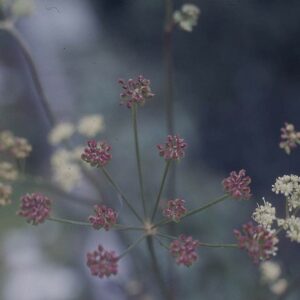

Pepper Saxifrage is a member of the carrot family and can be found in a range of grasslands across the country from meadows to roadsides. Pepper Saxifrage prefers a damper soil and will usually thrive more in this condition.
Best time to see
Flowers between June and September.
Did you know?
Despite it’s name, Pepper saxifrage doesn’t taste of pepper
Key facts about Pepper Saxifrage
- Height: 10-50cm
- Flowering Time: June – September
- Flower colour: Yellowy-white.
- Habitat: Typical habitats are damp grassland, water meadows and hay meadows.
Primrose (Primula Vulgaris)
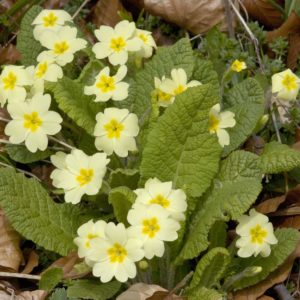

One of the first signs of spring is the arrival of the first primrose flowers. The scientific name, Primula vulgaris refers to its early blooming (Prim = first). Vulgaris of course means common. Sadly these beauties are no longer as common in the wild as they once were.
It’s easy to recognise the plants of primrose and its native cousin the cowslip. Their leaves are very distinctive. Once seen, never forgotten. Sitting close to the soil and arranged in a rosette, primula leaves are as wrinkly as a savoy cabbage. Forming the shape of a boat or an elongated spoon, the each leaf is narrow at the stalk end and has a gently rounded tip. Hairy on top and smooth underneath. Each one is a delight.
Uses for Primrose leaves and flowers
Beautiful growing in a shaded meadow and rather lovely in planters or borders. These little plants are more than just pretty. Flowers and leaves are edible.
Flowers can be coated in egg white and sugar and used to decorate cakes or simply added naked to a salad. The leaves can be cooked in soup but do have quite a strong taste. If you enjoy a tipple, the flowers can be made into primrose wine.
Historically, this little plant has been used to make analgesics, diuretic and expectorants.
Attractive to bees and butterflies and interestingly enough, ants. Their sticky seeds attract woodland ants who, in return for a sweet treat, disperse the seeds and help the plants to spread.
Folklore, myths and legends
In Norse lore, the primrose is the sacred flower of Freya, Goddess of Love. The Victorians too, associated this pretty little plant with amore. In the language of flowers, primrose means “I can’t live without you”.
If you are thinking of bringing a posy of primroses into the house, count them carefully. Any more or less than 13 can bring you bad luck.
As a time honoured woodland flower, it would have been remiss of us not to have included the primrose on our seed-mix for Woodland Shade Meadowmat. Where it sits alongside 36 other native wildflower species to bring colour and enhance biodiversity of lightly shaded areas in the garden.
Key facts about the primrose
- Height: up to 10cm
- Flowering Time: April – October
- Flower colour: Pale yellow with deeper yellow centres
- Habitat: Widespread across UK apart from parts of the Scottish Highlands and the area surrounding the Wash. Likes north facing banks and hedgerows away from hot sun.
Purple Loosestrife (Lythrum Salicaria)
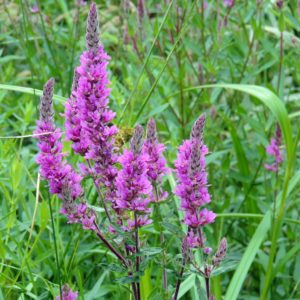

Available as one of the species in Turfonline’s Birds and Bees wildflower matting, Purple Loosestrife is also known as spiked Loosestrife or purple lythrum. Charles Darwin was fascinated by this wildflower, his Descriptioninterest piqued by the plant’s trimorphic flowers (meaning there exists three forms of the flower within the same species).
What does Purple Loosestrife look like?
Though considered as a purple wild flower, the six petalled flowers of the Purple Loosestrife can be more reddish-purple or crimson in colour. A perennial plant and noted on the RHS Perfect for Pollinators Plant List under the summer months, the Purple Loosestrife can grow up to two metres in height, with numerous stems growing out from one single root mass. It has tall, pink flower spikes and long, willowy leaves growing in opposite pairs up the stem. An adult plant can produce an estimated 2.5 to 2.7 million seeds annually.
A native species to Europe, as well as to Asia, north-west Africa and south-east Australia, this moisture-loving wildflower can tolerate a wide range of environmental conditions and can usually be found in wet habitats such as marshes, riverbanks, reed beds and wet meadows. It will perform well in moist soil or where there is a high water table. The plant flowers between June and August and is widespread across the UK, though less common in Scotland. Its foliage tends to redden because of dehydration in the late summer months (its species name is taken from the Greek name for blood – lythron – because of this) and this wildflower grows well in full sun or in partial shade.
A nectar-rich plant that promotes a successful model of biological pest control, Purple Loosestrife attracts many long-tongued insects, such as red-tailed bumblebees, elephant hawk-moths and brimstones, while the leaves provide food for the hawk-moth caterpillar as well as the black-margined loosestrife beetle. Leaving the foliage uncut until spring will encourage insects to hibernate within the plant’s dense foliage.
In herbalism, this wildflower is considered as a safe alternative for all age groups (including babies) as an astringent medicinal herb to help treat diarrhoea, dysentery and Irritable Bowel Syndrome. Research has suggested that the plant is markedly antibacterial and it is used as a natural ointment for ulcers and sores, as a way to soothe bruising, abrasions or irritated skin. It is also thought that using the stems as chewing sticks can prevent bleeding gums caused by gingivitis.
Key facts about Purple Loosestrife
- Height: 100-150cm
- Flowering Time: June – August
- Flower colour: Purple
- Habitat: Can be found in ditches, wet meadows, marshes and along side lakes and ponds
Ragged Robin (Lychnis Flos-Cuculi)
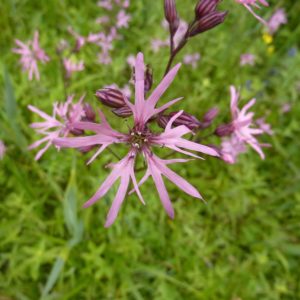

In recent times, bee and butterfly populations have been in decline and the Royal Horticultural Society recognises that many of us want to do all we can to help to fight this. The RHS is, therefore, seeking to help those of us who want to encourage such pollinating insects into our gardens by educating us as to what we can plant in our gardens to do so.
The RHS ‘perfect for pollinators’ list sets out 400 species of garden plants and wildflowers that it recognises as being particularly important for attracting pollinating insects to gardens. Turf Online makes life easier still by including many of the wildflowers that feature on the RHS perfect for pollinators list in their rolls of specially grown wildflower matting.
Perfect For Summer And Perfect For Pollinators
One such wildflower, the ragged robin (Lychnis Flos-cuculi), features on the RHS Perfect for Pollinators list as a herbaceous perennial that flowers during the summer months.
This pink wildflower, also known as the cuckoo flower, is one of Europe’s native species but numbers in the UK have declined as greater numbers of wetlands are drained for farming purposes. The plant grows from anywhere between 20 and 90cm in height, and has a long, thin stem with barbed, downward-pointing hairs. It has paired, untoothed leaves that vary from being oval and stalked lower down on the stem too long, narrow pointed leaves further up. Its flowers can be purple-pink, pale pink or white and are roughly 4cm in diameter, blooming throughout the summer months.
Where Does The Ragged Robin Thrive?
The ragged robin grows best in wet, boggy areas and is quite hardy. Bumblebees, honey bees and butterflies are all attracted to this flower, making it an ideal addition to your garden if you are conscious of helping native species of insects such as these to flourish.
Like many other wildflowers, ragged robins were once used in traditional, herbal medicines and remedies. Specifically, they were used in the belief that they would alleviate jaundice and more common illnesses such as headaches and toothaches. The roots and petals were also used, boiled, to wash clothes and hair. It was also once believed that if single men carried these flowers in their pockets and the flowers survived, they would soon find love.
Whether or not those things worked is unclear, but it is abundantly clear that planting these flowers as part of a meadow garden will attract pollinating insects, while also looking beautiful.
Key facts about Ragged Robin
- Height: 50-100cm
- Flowering Time: May – July
- Flower colour: Dainty pink flowers
- Habitat: Found along roads and in wet meadows and pastures.
Red Campion (Silene Dioica)
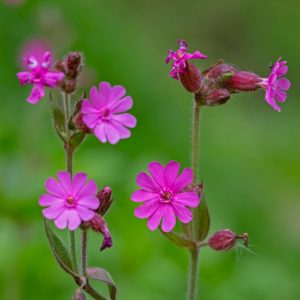

There are some 500 species of Silene around the world, including annuals, biennials and perennials. The greatest number can be found in the Mediterranean region, but the species is also found throughout Europe, the USA, Canada, Asia, South Africa and South America.
A handful of the Silene family are a native species in the UK, the most common of which is Red Campion (Latin name: Silene Dioica). This perennial or biennial has rose-red OR pink flowers and grows in coastal areas, on farmland, hedgerows, woodland and town parks. You will often see this pink wild flower appearing a few weeks after bluebells, in late spring, and it blooms until August or September, or in some areas even as late as winter if the weather stays mild. Plants with lighter pink flowers are often a hybrid mix of Red Campion and White Campion (Silene Latifolia). Red Campion is dioecious, which means the male and female flowers are produced on separate plants.
It produces plenty of seed, so while landscape gardeners are wary of Red Campion, it is a boon for wildflower meadow enthusiasts. Red Campion also has huge value for wildlife and ecology. The RHS recommends it as perfect for pollinators; its nectar attracts bees, hoverflies and butterflies. Silene derives from the Greek woodland God, Silenus, often depicted as a drunk and covered in a sticky foam (Silenus’ name comes from sialon, the Greek word for saliva). The female flowers of the Red Campion also produce a froth that is instrumental in catching pollen from these insects, hence the name.
Growing and harvesting Red Campion
Red Campion will grow easily from seed and can be sown in either the spring or early autumn. When the seedlings are large enough to hold, plant them into individual pots; once the plant is a sufficient size, divide and plant into soil in a partially shaded area. Alternatively, makes things easy for yourself and invest in Meadowmat, a pre-grown wildflower meadow that’s as simple to lay as lawn turf.
Traditional uses for Red Campion
Thanks to its lovely colour and relatively long-lasting blossom, Red Campion is a favourite herbaceous plant among gardeners who use it to brighten up borders. As well as being named by the RHS as perfect for pollinators, Red Campion’s leaves also provide food for moths. In some countries the crushed seeds of Red Campion have traditionally been used to treat snakebites. The Silene species have roots that contain saponin, a chemical compound long used as a soap for washing clothes.
Key facts about Red Campion
- Height: 50-100cm
- Flowering Time: May – September
- Flower colour: Rose Pink
- Habitat: Red Campions fill woodlands and roadside verges throughout the summer months.
Red Clover (Trifolium Pratense)
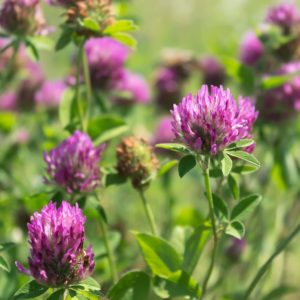

Red clover (Trifolium pratense) is a variety of clover and is a familiar sight in British meadows. Like its cousin, White Clover, Red Clover is often cultivated for fodder and re-grows very quickly after being cut. It is all things to all creatures; food for livestock, food for pollinating insects such as bees and butterflies and a natural soil fertiliser (as a legume), since it fixes nitrogen in the air, reducing the need for chemical fertilisers. Red Clover is also edible in that it can be used to make a herbal tea. In traditional medicine it is used as a sedative and to soothe skin complaints and is also used as an anti-inflammatory.
Although the common White Clover has a short stalk and much shorter leaves, the red clover has quite a tall stem and nestles neatly between narrow leaves. These leaves are not like the leaves commonly associated with clovers (three almost circular leaves grouped together or, if you are very lucky, four) and are instead rather more elongated and pointed at the tips. It grows to between 20 and 80cm in height and is a herbaceous perennial. Although described as a red wildflower, the Red Clover is more often a purple-red or pink wildflower, with its petals pointed upwards to the apex of an oval-shaped head.
Bees Love Red Clover as a Source of Nectar
Beekeepers are fond of Red Clover since it is a major source of nectar for honeybees as well as bumblebees.
A native species in Britain and Europe, the Red Clover has been in decline in recent years, probably because of the decline in bumblebee and honeybee numbers. The bumblebee is its most frequent visitor but for various possible reasons (from an increase in intensive farming to a virus) the bee population has been dropping steadily.
Why Help Protect Red Clover and Other Pollinators
It is for this reason that it is so important that gardeners are being encouraged to make space in their land for wildflowers that encourage pollinators. The RHS Perfect for Pollinators list includes Red Clover as a species that will aid in the quest to increase or at least preserve numbers of bees and butterflies in Britain. For maximum impact, these should be planted together with a wide range of other wildflowers to encourage as many species as possible to visit our gardens. It is possible to buy pre-planted rolls of meadow turf from Meadowmat, to lay in your garden for quick and easy growth of vital wildflowers.
Key facts about Red Clover
- Height: 10-50cm
- Flowering Time: May – September
- Flower colour: Pinkish red
- Habitat: Grows best in fields, lawns and roadsides.
Ribwort Plantain (Plantago Lanceolata)
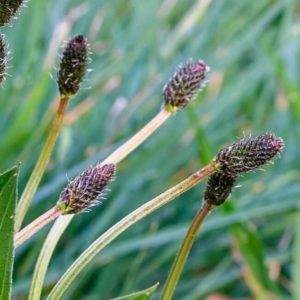

Ribwort Plantain (plantago lanceolata) is a perennial plant and a native species in Europe; it is a common sight across the UK countryside, in arable fields and grasslands. It is a hardy plant and can grow in most types of soil and in dry areas, for example on embankments and roadsides. Ribwort Plantain contains nutrients and vitamins such as calcium and potassium, and is a common part of a sheep’s diet.
Ribwort Plantain has dark green, ribbed leaves and spiky flower heads, usually a greenish-white colour. Flowering begins in April and lasts until the first frost of winter. Like many wildflowers, Ribwort Plantain is named by the Royal Horticultural Society (RHS) as ‘Perfect for Pollinators’ – its rich nectar attracts butterflies, bumble bees, and other insects, so it helps to support the eco-system and promote biodiversity. Ribwort Plantain attracts moths and hoverflies and also provides birds with a source of food in wintertime.
Growing and harvesting Ribwort Plantain
Plants may flower in the first year but sometimes rosettes have to reach a minimum size before flowering can start. Sow in springtime and, once the seeds are large enough, pop them out of the pod and sprinkle into soil in the summer. After the first year, Ribwort Plantain self-germinates. The stalks have flowers which will each become a seedpod with up to 20 seeds. On a mature plant, when the pod splits it spreads the seeds and the growing season begins again.
As an alternative to growing Ribwort Plantain, you can keep things ultra simple and invest in Meadowmat, a pre-grown wildflower meadow that’s as easy to lay as lawn turf. Meadowmat and organisations such as the RHS can provide further advice and tips about which wildflowers to plant, how to plant them and their benefits.
Traditional uses for Ribwort Plantain
Ribwort Plantain may not be the prettiest plant in the flora world but it has many uses. It attracts wildlife, is used for grazing by sheep and rabbits, and attracts pollinators and other insects. It also has medicinal properties. It is antibacterial and an astringent and has historically been used to stem bleeding. These days it is used by herbalists to treat various ailments and injuries, including sores, wounds, urinary infections, catarrh and sinusitis. Ribwort Plantain is also used as a tea to treat eczema and other skin disorders.
Key facts about Ribwort Plantain
- Height: 10-50cm
- Flowering Time: April – October
- Flower colour: Grass-like with blackish brown flowers.
- Habitat: A very hardy plant that can be found in any environment, particularly fields, lawns, meadows, roadsides and parks.
Rose Campion (Lychnis coronaria)
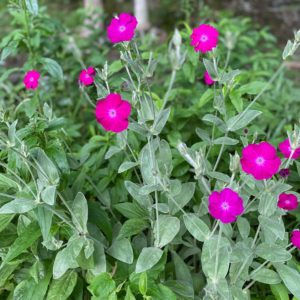

Rose campion is one of about 20 species of perennials and biennials in the genus Lychnis. This group in the pink family (Caryophyllaceae). Rose campion combines nicely with pink, lilac, purple, and blue flowers and contrasts well with bright yellow flowers, It can also be paired with other magenta flowers such as winecups.
Key facts about Rose Campion
- Height: 50-150cm
- Flowering Time: July – August
- Flower colour: Pink
- Habitat: Found on dry light soils such as dunes, heaths and waste ground.
Rough Hawkbit (Leontodon hispidus)
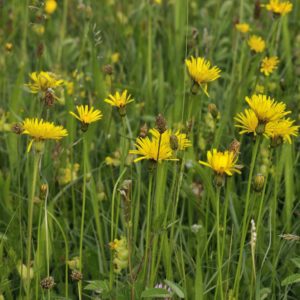

The Rough Hawkbit is a perennial plant with yellow dandelion flowers that forms a rosette of coarsely hairy, lobed leaves, with leaflets and unbranched stalks bearing yellow. The seed heads form a clock that attracts different breeds of birds, this plant also gives off a pleasant fragrance.
Did you know? –
If you have a 10x hand lens, have a look at the hairs on the stems and underside of the leaves. Some of them will be forked at the tip.
Key facts about Rough Hawkbit
- Height: 10-50cm
- Flowering Time: May – October
- Flower colour: Yellow dandelion flowers.
- Habitat: Often found on well drained soils, railway embankments and other grassy environments.
Salad Burnet (Sanguisorba Minor)
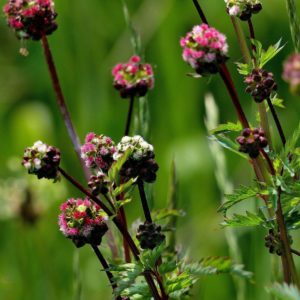

Salad Burnet (or sanguisorba minor) is a perennial plant with dark red wildflowers and lacy ferns, which can grow up to 12 inches tall. A member of the rose family, Salad Burnet is a native species in Europe, but also grows in western Asia and parts of northern Africa. Salad Burnet has edible leaves and was a very popular ingredient in Tudor times. It is also known for its medicinal properties – even being used in an attempt to treat the plague at one point in history.
Salad Burnet is named by the Royal Horticultural Society (RHS) as perfect for pollinators; its rich nectar attracts bumble bees, butterflies and other insects, which in turn helps support the eco-system and promote bio diversity.
Growing and harvesting Salad Burnet
Salad Burnet is easy to grow and the seeds can be sown all year round. It is a hardy perennial plant which thrives in both partial shade and sun, and most soil types. And as well as using it to create your wildflower meadow, consider using seeds and cuttings to add colour to your garden or patio – this plant’s delicate, draping leaves and red wildflowers make it a great addition to containers or window boxes. Do not over water and keep trimming so it flourishes; cared for Salad Burnet will provide warmth and colour even during dark winter days. When harvesting, wait until the plant is around six to eight inches in height, so that the remaining plant continues to flourish.
As an alternative to growing Salad Burnet, you can keep things simple and invest in Meadowmat, a pre-grown wildflower meadow that’s as easy to lay as lawn turf. Turfonline and organisations such as local Wildlife Trusts and the RHS can provide further advice and tips about how to plant wild flowers, and their many benefits.
Traditional uses of Salad Burnet
A much admired wildflower, thanks to its pretty red flowers, Salad Burnet is grown for its aesthetic qualities. It is also used for culinary purposes (as its name suggests) and reputedly has several medicinal properties thanks to its astringent properties.
Used as a herb, Salad Burnet has a clean, crisp flavour, similar to cucumber. It’s used in salads and in dressings and it can also be added to drinks. It’s an easy-to-grow plant that appears early in the season and copes well with heat, so is a useful ingredient to have and to use throughout the summer.
Key facts about Salad Burnet
- Height: 50-100cm
- Flowering Time: May – August
- Flower colour: Unusual purple tinged flowers.
- Habitat: Often found on download, meadows, roadside verges and quarries.
Sainfoin (Onobrychis vicifolia)
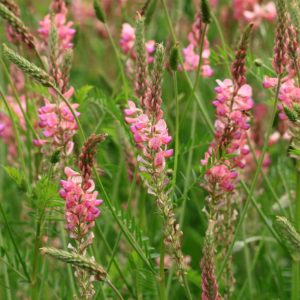

Sainfoin is a perennial plant from the pea family that can be found throughout the UK but predominantly found in the south and southeast of England and around East Anglia, it prefers dry grassland and limestone soils and can be found along roadsides, banks, quarries and railways.
Information
- Up to 40cm
- 6 – 12 pairs of narrow leaflets
- Will lengthen productive life from two to three to about six years in irrigated areas
- Seeding depth should be between 0.25 and 0.75 inches.
Did you know?
- Sainfoin was commonly grown as a fodder plant from the seventeenth century onwards, until the introduction of chemical fertilisers in the 1950s.
- It is highly palatable to livestock, as well as helping to prevent parasitic worm infections in cattle and reduce methane production.
Key facts about Sainfoin
- Height: 10-50cm
- Flowering Time: July – September
- Flower colour: Dark purple buds turning into paler flowers.
- Habitat: Often found in roadsides, banks, quarries and railways.
Sea Campion (Silene maritima)
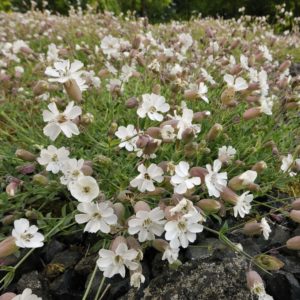

The sea campion is a common sight on the seacoasts of western Europe and can be found between rocky crevices that give shelter to the wildlife on coastal cliff edge. Each blossom is adorned with five bi-lobed petals and an inflated green tinged fused calyx.
Although this is a perennial flower and is short lived the sea campion is self-seeded.
The sea campion is rich in pollen meaning it attracts pollinating inspects which includes bees and butterflies.
Further Information
- Scientific name is Silene uniflora
- Can grow anywhere between 12cm and 15cm in height and 20cm wide
- Needs full exposure to the sun
- Shelter for wildlife
- Low maintenance
- Native to coastal regions of western and northern Europe.
Key facts about Sea Campion
- Height: 10-50cm
- Flowering Time: June – August
- Flower colour: White.
- Habitat: Found along the coastline of Britain on limestone.
Selfheal (Prunella Vulgaris)
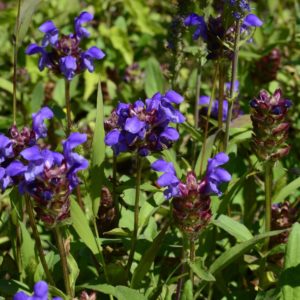

Selfheal (prunella vulgaris) is a short grassland perennial wildflower with bright green, oval-shaped leaves. The flowers are a vibrant shade of purple, violet and green, hooded and two-lipped, and bloom from June to September. A native species of the UK, selfheal is found in grasslands, meadows, lawns, roadsides and woodland clearings. It can be as short as 2 cm – you might well have some covering part of your lawn – and grow as tall as 40 cm in wilder, less cultivated places.
Selfheal blooming in Meadowmat Roofmix
Selfheal is one of many wildflowers that are part of the Royal Horticultural Society (RHS) Perfect for Pollinators list; its rich nectar attracts bumble bees especially, as well as butterflies and other insects. So by growing selfheal in your garden, you can help promote bio diversity and support the eco-system.
Growing and harvesting selfheal
Selfheal can be planted at any time of the year, using seeds or plant cuttings. It is a short and relatively slow growing plant which can be quickly dominated by taller, more vigorous vegetation, so either plant it in a gentle wildflower meadow where it will find its way and provide attractive ground cover, or cut back the taller vegetation. Once given space to grow, selfheal can flourish. Cuttings of the purple wildflower make a pretty floral display inside the house.
As an alternative to growing your own selfheal, why not keep things really simple and invest in Meadowmat, a pre-grown wildflower meadow that’s as easy to lay as lawn turf? Turfonline and organisations such as the RHS and local Wildlife Trusts can offer further tips and advice about wildflowers and their many benefits.
Traditional uses for selfheal
Selfheal attracts pollinators, insects and birds. It is also used for its culinary and medicinal properties. It is very nutritious and the leaves and flowers are packed with antioxidants. The leaves can be eaten raw but cooking takes away their mildly bitter taste. They are most commonly added to salads or soups, used as a herbal tea, or added to cold water to make a flavoursome and nutritious drink.
Selfheal has long been used in Chinese medicine; its cooling properties are thought to ward against fevers and help treat liver and kidney disorders. It is an antibiotic and is believed to help lower blood pressure.
Key facts about Selfheal
- Height: 10-50cm
- Flowering Time: June – September
- Flower colour: Violet/purple.
- Habitat: Can be found in turf, grassland, woodland clearings and roadside verges.
Sheeps Bit (Jasione montana)
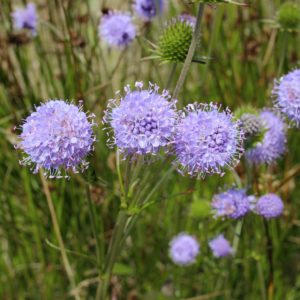

Densely packed blue flowers, sometimes with a wavy edge. You will spot them borne above a rosette of narrow leaves, Bright blue round heads that are eye catching
Did you know?
Sheep’s bit is clearly visible under a UV light (Ultraviolet), This makes it attractive for bees and butterflies.
This plant got its name from the simple fact that sheep enjoy eating it.
Key facts about Sheeps bit
- Height: 10-50cm
- Flowering Time: June – August
- Flower colour: Blue.
- Habitat: It is a rock plant growing on heaths and moors at a high elevation in rocky districts, coastal cliffs, quarries and natural escarpments where the soil is thin.
Small Scabious (Scabiosa Columbaria)


A garden that contains a wide variety of plants and wildflowers will attract a wider variety of birds, bees and butterflies – all creatures that we like to see in our gardens and that need our help to survive in times when their other natural habitats are in decline. As hedgerows and woodlands are being cut down to make room for building and farming, it is important that pollinating insects in particular are given opportunity to continue to thrive.
Meadowmat rolls of pre-planted matting feature a wide range of different wildflowers to enhance the beauty of any garden, and are very helpful for quickly and easily setting up a natural space that attracts insects. These plants flower at different times throughout the year to maximise the number and variety of pollinating insects that will visit, as different species of butterfly, for example, hatch, take flight and produce eggs and larvae throughout the spring and summer.
Late summer bloomer
One variety of wildflower that will bloom in late summer (July to September) is the small scabious (scabiosa columbaria). This blue wild flower is a native species in Britain and can flower for even longer (from June to October) if the conditions are right. It likes lots of sunlight and well-drained soil, and it loves wildlife borders.
Attracting butterflies
Commonly known as the ‘butterfly blue’, quite it is highly attractive to butterflies like peacocks and tortoiseshells. It is featured as one of the herbaceous perennial plants on the RHS perfect for pollinators list, cementing its reputation as an excellent choice for a wildflower garden.
It has a large, round, pale blue head that, when it’s going to seed, looking not unlike the shape of a thistle. When in full flower, though, the petals are clustered tightly in the centre and relax towards the edge of the circular head; each has five petal-lobes that are easier to see towards the outermost edge and distinguish this variety from the similar field scabious.
The small scabious can grow quite tall, to around 70cm, with a slender stem that, compared to the field scabious, has few hairs.
Historical uses of small scabious
Folklore is behind the name, since this flower (like its relative, the field scabious) was believed to cure skin complaints including dandruff, wounds and scabies. But it has always been grown in British gardens because of its pretty colour, and its lack of associated pests make it easy to grow and maintain.
Key facts about Small scabious
- Height: 50-100cm
- Flowering Time: June – October
- Flower colour: pale blue.
- Habitat: Often found in meadows, pastures, embankments, verges and even quarries.
Soapwort (Saponaria officinalis)
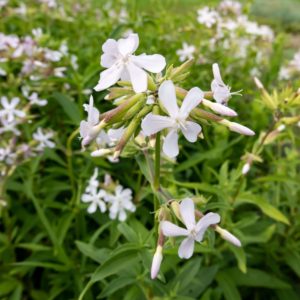

Soapwort can be found throughout the UK but especially in S.W. England and N. Wales, where it has sometimes been considered native, however there has been evidence of soapwort in Asia. It is naturalised by streams across the UK with it also being found in damp woods.
The germination process often takes around three weeks. Soapwort will thrive in the full sun but will also be perfectly fine with the shaded areas.
Fun fact
Soapwort can be used to make soap simply by adding 1 tablespoon of grounded root and 250 ml of water. Boil for 30 minutes, then cool and strain. Shampoo: use 1 tablespoon of Soapwort Root and 1 cup water. Boil the water and add the soapwort.
Key facts about Soapwort
- Height: 50-100cm
- Flowering Time: July – September
- Flower colour: White or Pink.
- Habitat: banks of rivers and streams, roadside verges, railways, meadows and waste areas.
Sweet Violet (Viola Odorata)
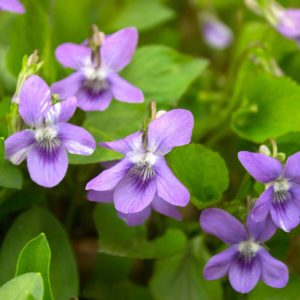

One of the prettiest and most commonly overlooked wildflowers in the UK. The sweet violet is shy and undemanding yet, if ever you do spot one blooming amongst the grasses, you cannot help but smile.
Hairy, heart shaped leaves sit close to the ground and emerging from the centre of the plant are the long flower stalks. The flower stalks are leafless and sitting at their very end is a single, delicate flower.
The word “sweet” refers not to the very attractive flowers, but to their gorgeous scent. Out of the 10 species of violet that grow wild in the UK, this is the only one that smells.
Uses for Sweet Violet
Historically, the oils have been distilled to make perfume and flavour sweets for thousands of years. Allegedly since the time of Cleopatra. In more recent times, Sweet violet flowers were spread on the floors of cottages and churches to disguise bad smells. If you find these little flowers growing beneath trees there’s a strong chance that you are in ancient woodland.
Bees love these little flowers, not least because they bloom beautifully early in the year. In a mild winter, they’ll appear from February onwards. From a conservation point of view, these little beauties are a key food source for some fritillary butterflies.
Folklore, myths and legends
Humans have been fascinated by plants and flowers for centuries. Myth has it that the Goddess Diana hanged one of her nymph companions into a violet to protect her from the amorous advances of Apollo. From then on, we have associated violets with modesty.
Because it is linked to modesty, faithfulness and humility, it is traditional to give violets as a 50th wedding anniversary present. Dreaming of violets is supposed to indicate that good fortune is on its way. It’s also supposed to mean that your future spouse will be younger than you.
This tiny flower, that we’re so proud to have included in the seedmix for Cottage Garden Meadowmat, will hopefully bring you happiness for many reasons and for many years.
Key facts about the sweet violet
- Height: up to 10cm
- Flowering Time: February – April
- Flower colour: Deep Purple. White flowered forms appear occasionally
- Habitat: Widespread across UK but rare in Scotland. Likes light shade and chalky soils. Commonly seen on road verges and railway embankments.
Tansy (Tanacetum Vulgare)
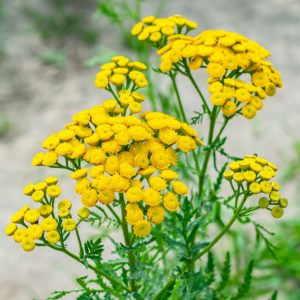

Description
Tansy flowers look like some sort of a mutant. The flowers are held high in little groups, but what is unusual is that they don’t appear to have petals. These plants are members of the daisy family. They look just like a daisy with the petals picked off and only the bright yellow centres remaining.
The leaves of the tansy plant remind me of Yarrow leaves. They are finely branched and almost fern-like in their appearance.
Uses for Tansy
Before the advent of the NHS, Tansy was an important plant in the poor man’s medicine chest. The leaves taste quite bitter and were eaten in spring to detoxify the body after winter. They were also used as a vermifuge. In other words to treat infestations of worms.
Another, surprising use for Tansy is as a culinary herb. The leaves have a distinctive smell but actually make a good substitute for expensive spices. Tansy can imbibe a dish with a flavour similar to nutmeg and cinnamon. Try it combined with egg for breakfast or lunch….but don’t use too much. Tansy oil contains the substance Thujone which is toxic. Definitely don’t eat tansy if you are pregnant.
In the garden, aside from being a decorative plant, tansy can be used to create an insecticide. Steep the leaves in water for a couple of days before straining off the liquid and using it to control aphid infestations.
The flowers are beautiful when dried and brought indoors. Pick them in full bloom and suspend the stems upside down in a dark dry and airy place until the stems are straw like and completely dry.
Folklore, myths and legends
An old wives tale suggests that popping a tansy leaf into your shoe will ensure a safe journey. It is well known as a preservative.
Apparently the Ancient Greeks would wrap their dead in Tansy leaves to preserve the corpse until it was time for burial. The insecticide properties were also employed in storing meat.
Finally, tansy is known as the Bible Flower. Tansy leaves were used as bookmarks in the bible and emitted a nice minty scent when the book was opened.
Tansy is a fascinating plant with many uses and a beauty all of its own. If you would like to grow it in your own garden, why not establish a wildflower garden? You’ll find tansy growing alongside several other, equally interesting plants in Meadowmat for Birds and Bees.
Key facts about the Tansy
- Height: 50-100cm
- Flowering Time: August – September
- Flower colour: Golden yellow
- Habitat: Common throughout the UK except in mountainous regions. You’ll find tansy thriving in field borders and on riverbanks and roadsides. It’s a perennial plant and will keep growing for many years.
Teasel (Dipsacus Fullonum)
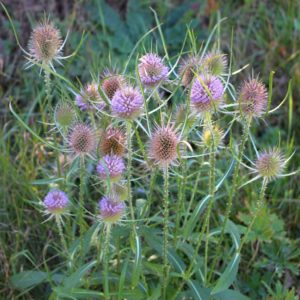

An unmistakable addition to a MeadowMat wild garden, teasel (dipsacus fullonum) really stands out from any other wildflower thanks to its impressive height of around six feet.
This biennial plant spends its first year developing a ring of long pointed leaves that stay close to the ground. In its second year, Teasel are recognised by the green spiny stems and heads that grow in spring and summer. The rich colour of the purple wild flower that grows from the head makes the teasel beautiful to look at and makes a fascinating centrepiece.
Teasel will often remain on show for years after the plant’s life span, drying and turning brown after seeding.
The teasel flowers in the most remarkable way. Around July and August, a ring of tiny purple wild flowers will sprout from the middle of the spiny head before widening out towards the top and bottom. However, as new flowers bloom, the earlier blooms will die away. This results in two separate flower belts climbing towards the top and bottom as the flowers develop.
Teasels to attract wildlife
These flowers are highly favoured by bees and insects. The teasel is highly recommended by the RHS as perfect for pollinators.
The seeds that mature in the autumn also provide a much needed food source for birds such as the goldfinch. This makes them a great border plant for gardens as both a striking plant to look at and as a help to garden wildlife.
Traditional uses for the teasel
The teasel has often found use after its natural cycle in a number of ways. Obviously, the long stems and spiny heads have made perfect additions to ornamental florist arrangements. But the dried teasel heads have also found a use in much less horticultural areas. Fuller’s teasel was cultivated for use as a tool for use in the textile industries. The heads made perfect combs for cleaning, raising and aligning wool and other fabrics, until metal combs largely took over in the 20th century. But there are still some today who prefer the teasel, claiming better results and less damage to cloth in working.
Where to see teasels
A native species to the UK, dipsacus fullonum will often be found in the wild in damp grass lands close to the edge of fields. However, don’t be surprised to find them sprouting along roadsides and wastelands as they make the most of the disturbed ground. Teasel is a hardy plant and will grow in most soils, making them easy to cultivate and care for. They are an ideal part of any wild garden and an important species in the seedmix for Birds and Bees Meadowmat.
Key facts about the Teasel
- Height: 150-250cm
- Flowering Time: July – August
- Flower colour: Purple
- Habitat: Teasel thrives in open sunny spaces. It can often be found on roadsides, open woods, roadsides, grassland, railway banks and hedgerows.
Thrift (Armeria Maritima)
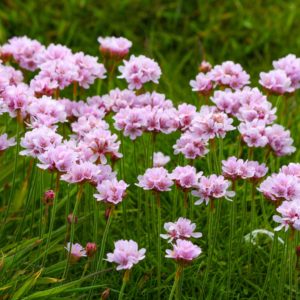

One of the prettiest UK wildflowers. Thrift is also known as sea pink or sea lavender and has such lovely pom-pom shaped flowers that it’s often used as a garden plant.
Leaves are long and narrow and feel spiky to the touch. This is their self-defence mechanism to protect them from strong and salty winds. These little plants are found on nearly every British Coastline and are particularly happy on the west coast. The Lizard in Cornwall turns pink with these flowers every spring!
Uses for Thrift
This awesome little plant is incredibly deep rooting and can cope with the harshest of conditions. It doesn’t mind free-draining soil because it can dig deep to access water. It can even cope with road salt.
Thrift belongs to a plant family called Plumbaginaceae (plum-ag-in-ay-see). During the industrial revolution, people believed that all the plants in this family could cure lead poisoning. Which is why thrift is so often found on the site of old lead mines.
Plant this little flower in alpine gardens to enjoy them as individuals or bring them into the cottage garden – the bees will love you for it. Personally, I think thrift is second only to lavender as an edging plant. You can also dry the flowers to use in indoor arrangements.
Thrift in Meadowmat
We’ve included Thrift in Cottage Garden Meadowmat and Heritage Mix Meadowmat for lots of good reasons
- Drought tolerant, copes with harsh conditions
- Attractive to pollinating insects
- Colour compliments the pink, blue and white colourways of most of our wildflowers
- Low growing
- Not too fussy about soil type
- Frost hardy
- Evergreen – adds extra winter interest
Key facts about Thrift aka Sea Pink
- Height: up to 30cm
- Flowering Time: April – October
- Flower colour: Baby pink
- Habitat: coastal habitats, shingle beaches, heathland, around abandoned metal mines, riverside shingle
Tufted Vetch (Vicia Cracca)
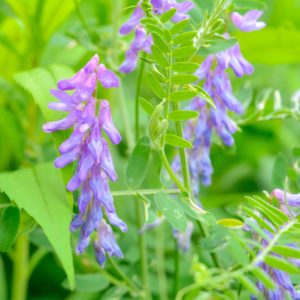

Tufted vetch, also known as cow vetch or bird vetch, is a striking, purple wildflower that looks not unlike a tiny sweet pea. The Latin name is vicia cracca and it grows happily on the edges of woodland, up banks, along scrubland and in amongst grassland – making it a very versatile wildflower.
The tufted vetch is a British native species of wildflower which has violet blue, tube-shaped flowers and long, greyish green leaves. It is a member of the clover and pea family of plants, and the flowers, which grow in rows up one side of the stem, are delicate and attractive.
The flowering season is quite lengthy and lasts from June to August, after which time, pods are produced with eight to 10 tiny seeds in each. As the seed pods ripen, they turn dark brown to black.
The vicia cracca climbs and leans against other plants in order to reach the sunlight, and it produces tendrils at the end of its leaves to help with this. The tendrils wrap themselves around any stems or grasses nearby and it pulls itself to where it needs to be.
Different Ways You Can Use Tufted Vetch
The bright purple flowers are often heavy with pollen so they attract bees of different species. Tufted vetch is on the RHS Perfect for Pollinators list, and plants on this list are visited by flies and butterflies alike. To create an area that’s a haven for pollinating wildlife, a Meadowmat containing this plant is an ideal solution.
The tufted vetch is a useful wildflower. The seeds can be eaten by humans if boiled or roasted and the leaves are used as a tea alternative. Pet birds, such as budgies, can be fed the seeds as a nutritional snack too.
This tiny plant is also beneficial to the soil because it turns nitrogen, which it takes from the air, into nitrogen oxide. This enriches the earth and makes it more fertile.
Vicia cracca is also good at preventing soil erosion as its roots hold the earth in place and stop it from being worn or washed away. This little plant is also used as a green manure when turned over and left as a natural mulch in ploughed fields.
Key facts about Tufted Vetch
- Height: 50-100cm
- Flowering Time: June – August
- Flower colour: Bright Blue
- Habitat: It lives happily in many different habitats, including woodland edges, scrubland, coastal margins and grassland.
Vervain (Verbena)


Pretty pink flowers are held aloft on strong stems. Vervain has several trumpet shaped flowers to each spike, and several spikes to each stem. The hairy leaves are in pairs and often divided into lobes with curved teeth. If you think the leaves look familiar, you’d be right. This plant is closely related to Verbena bonariensis – a popular garden plant.
This plant seems to thrive where no other does. It can eke an existence in very poor soil. In a garden setting it’s not only attractive to pollinators, it’s generally very reliable.
Where to use Vervain
Such a pretty plant deserves a place in any garden. This little wildflower has a very traditional feel to it – which of course is why we added it to the seedmix of Cottage Garden Meadowmat. I can imagine this plant growing in a rockery or a prairie type planting scheme. It would work well in a dry garden and as part of a diverse border.
What of the ancients? How did they use vervain? The scientific name “Verbena” refers to plants that were used by Druids during sacrifices. In Medieval times, our ancestors prized for vervain for its medicinal qualities. This plant is used to treat headaches and to relieve insomnia. Interesting then that this plant is a cousin of lemon verbena the plant we still use today to create a tea that will aid relaxation and sleep.
- Robust plant that enjoys sunny spots and poor soil
- Beautiful pink flowers
- Open structure that interweaves with neighbouring plants
- Easy to grow
- Late summer flowering when bee forage is in short supply
Key facts about Vervain
- Height: 30-75cm
- Flowering Time: July – September
- Flower colour: Baby pink
- Habitat: Grassy places in full sun
Vipers Bugloss (Echium Vulgare)
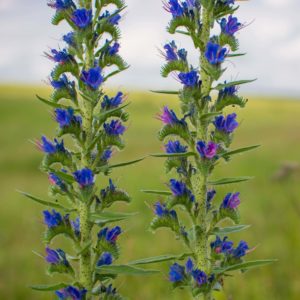

Vipers bugloss (Echium vulgare) is an upright flowering wildflower that grows to around 90cm. In full bloom its funnel-shaped blue flowers grow densely all around the stem from close to the ground all the way up to the tip, interspersed by dark green deciduous leaves. From the centre of the blue flowers sprout long black stamens that have given this flower its name, since they look not unlike forked snakes’.
This hardy biennial blue wild flower is a native species of wildflower in much of Europe and Britain. It is long flowering, from May to September, making it an ideal flower for planting in a wildflower garden aimed at attracting bees, butterflies and moths. Indeed, it is one of the RHS ‘perfect for pollinators’ wildflowers, as featured in their list of which garden plants and wildflowers are best for attracting pollinating insects.
Vipers bugloss is happy in full sunlight or in part shade, making it easy to plant and maintain. It is one of the many species available in a Meadowmat, a pre-planted roll of turf interlaced with a wide variety of wild flowers aimed at attracting as many native species of bees and butterflies and moths as possible.
Its most frequent visitors are the burnet moth (a small, distinctive-looking, brightly coloured moth that is often mistaken for a butterfly, with black wings covered with large red spots) and bumblebees, particularly the red-tailed and buff-tailed varieties. Painted lady butterflies and honeybees are also attracted to this non-scented, nectar rich wild flower. The large number of pollinating insects it attracts plus the length of time over which it flowers makes it an excellent choice for any wild flower garden. A well-pollinated garden obviously means that further flowers and plants will grow year upon year, but will also be crucial in supporting local wildlife.
Other names for this wild flower include Thistle Blueweed and Viper Grass, though it’s Latin name comes from the Greek ‘Ekbis’ (‘viper’) and ‘vulgaris’ (‘common’). Folklore will tell you that it was so named because snakes like to hide between the long, dense stems of groups of these flowers, or that it is poisonous. Indeed, ingesting a lot of viper’s bugloss over a long time will cause liver failure, but it is otherwise not terribly poisonous. The reason for its name is simply down to its appearance, which people believe to be rather like a snake.
Key facts about Vipers Buglos
- Height: 50-100cm
- Flowering Time: May – September
- Flower colour: Vivid Blue
- Habitat: Often found on grassland, cliffs, sand dunes and dry banks.
Water Avens (Geum Rivale)
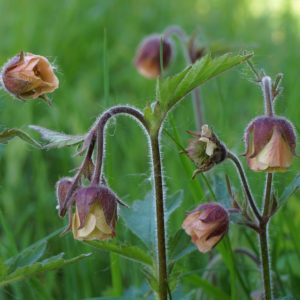

One of the prettiest wildflowers we know. Water avens has delicate nodding flower heads. The apricot coloured petals form an upside down cup shape that contrasts beautifully with the crimson coloured calyx. Almost like a fairy’s costume and clearly the inspiration for one of the Burren Flower Fairy illustrations. The calyx is the same colour as the stem and the buds.
Leaves are very much like garden geum varieties. They are held close to the ground and have three to six pairs of deeply lobed leaflets.
Seed heads are feathery and not unattractive.
Uses for Water Avens
If you have a damp garden and you enjoy attracting wildlife to your plot, this is the plant for you. Not only does it attract butterflies and bees, it’s also a beacon for other insects. And who loves insects? Why frogs and toads of course.
This beautiful little flower is a visual delight and a major contribution to a flourishing eco system.
On a green roof, it is perfectly happy in windy conditions and adds interest for wildlife.
Medicinally, it does have uses too. Apparently the root of water avens can be made into a flavourful tea and was used by Native Americans to treat children with Dysentry.
The dried root is said to repel moths – so might be worth popping into your wardrobe.
We’ve included Water avens in our Heritage variety of Meadowmat for lots of good reasons Meadowmat
- Easy to grow
- Enjoys rooftop conditions with minimal human interference
- Shallow rooted so when used on a roof it won’t compromise waterproofing
- Bee friendly
- Butterfly friendly
- Low growing
- Copes with dappled shade
- Happy in damp growing medium
- Frost hardy
- Perennial
There’s a Meadowmat variety for almost any garden or landscaping project. Take a look at the selection to find out more.
Key facts about Water Avens
- Height: 30-60cm
- Flowering Time: April – June
- Flower colour: Crimson red calyx with apricot coloured petals
- Habitat: Common in Scotland and the North of England but rare in south west England. Loves wet meadows, marshes, fens damp woodlands and stream sides. Prefers shaded conditions.
White Breeze
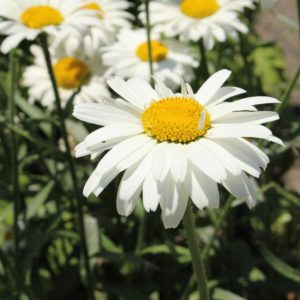

White breeze is a common plant that you will spot often over the UK, It is described as a robust herbaceous perennial with narrowly oblong leaves and daisy like flower heads with white rays
Key facts about White Breeze
- Height: 30-60cm
- Flowering Time: July – October
- Flower colour: White petals with a yellow centre
- Habitat: A great plant for flower beds, borders and even as a cut flower.
White Campion (Silene Latifolia)
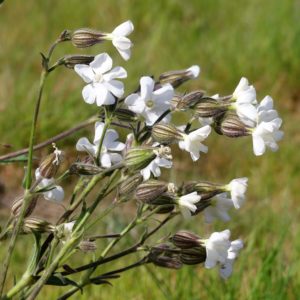

A member of the Pink family, white campion (Silene latifolia) is a common sight in hedgerows and around the edge of fields. It is also known as the Flower of the Dead or the Grave Flower because of its tendency to grow in the grassy areas of graveyards.
Growing up to a metre in height, they produce clusters of white flowers that spread up to 3cm in diameter. Each flower has five petals that are shaped like love hearts (they are ‘bi-lobed’) and these emerge from a swollen bladder-like calyx. The stem splits into two close to the flowers, and at the split, there are two stalkless, oval, hairy leaves.
Where Did The White Campion Come From?
This white wildflower is a native species in Europe and Asia, though it prefers more shaded woodland areas in hotter parts of the world. It is a long-flowering breed, budding by May and flowering until October. Its petals also stay open until late evening, when they become slightly scented, making it attractive to moths, an important pollinator.
As more and more people turn over parts of their gardens or allotments to allow pollinating flowers and plants to grow, to encourage native species of bee and butterfly and other pollinators, this wildflower is becoming a more familiar sight in many more areas across the UK. Available as one of several varieties of wildflower in a Meadowmat it can be quickly and easily grown and incorporated into any outdoor space in the same way as turf can.
Wildflowers are very easy to grow and maintain and bring beauty in the form of their vibrant colours and in the array of wildlife they attract. As well as moths, the white campion attracts hoverflies and beetles, and add a splash of colour to any wildflower meadow.
What Uses Does The White Campion Have?
The white campion has also had many uses in the past, including for washing clothes and hair, and even to treat warts and corns. During the reign of Elizabeth I this species was made into a soothing drink, combining it with sugar and wine. In more modern times, the roots are known to be toxic to the larvae of mosquitoes and are used as a deterrent in areas where mosquitoes are problematic. Some people still boil up the roots to make soap.
If you are interested in incorporating some of these pretty wildflowers in your garden, a Meadowmat is the easiest and surest way to do so.
Key facts about White Campion
- Height: 50-100cm
- Flowering Time: May – September
- Flower colour: Pure white
- Habitat: Grows in most open habitats, particularly wasteland and fields, most commonly on neutral to alkaline soils.
White Clover (Trifolium repens)
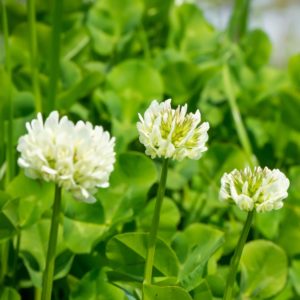

The scientific name for clover is Trifolium which gives a clue to it’s appearance. Tri = three and folium = leaves. Each clover leaf has three distinct lobes.
The leaves are more or less hairless and each one has a white spot on it. Flowers are distinctive. Globe shaped and held aloft on long, slender stems. Each flower head is made up of a group of white tube-shaped florets. Once seen, never forgotten.
Uses for White Clover
Surely one of the most valuable pollinator plants in entire vast plant palette of the UK. White clover is a great nectar plant, but more importantly the pollen is protein rich and highly nutritious. Pollen is bee baby food and the better its quality, the healthier the colony.
White clover is good for plants too. Like peas and beans it is a legume. Which means that it can gather nitrogen gas from the air and fix it into the soil to provide natural plant fertilisation.
We’ve added white clover to three of our Meadowmat varieties because it is so very good at attracting pollinating insects. It’s easy to grow because it’s not fussy about soil type and arguably one of the most reliable wildflowers.
- Bee friendly – particularly for bumblebees and solitary bees
- Easy to grow
- Tolerates trampling, mowing and grazing
- Frost hardy
- Perennial
- Very pretty flowers
Key facts about White Clover
- Height: 10 – 50cm
- Flowering Time: May – October
- Flower colour: White
- Habitat: Very common. Found in lawns, grazing pasture, roadsides on all but the wettest and most acidic soils
Wild Basil (Clinopodium Vulgare)
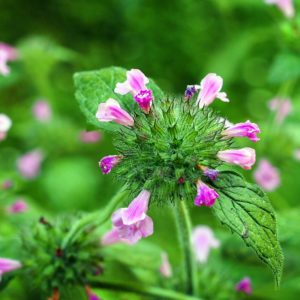

Wild basil (properly known as clinopodium vulgare) is a herbaceous wildflower in the Lamiaceae family. It is recognisable by its slightly square stem and oval, toothed leaves. As a perennial plant, wild basil lives for longer than two years. It flowers between July and September, when it produces whorls of delicately-coloured flowers at the top of each stem. The flowers range in hue from rich purple to vibrant violet to subtle pink. Each of these flowers has five petals that form a loose bell shape and five exquisite stamens, which add to the wild basil’s unique and remarkable appearance.
Wildlife
This gorgeous purple wild flower is also a UK native species that provides nectar to many of our country’s most beloved pollinators, including bees, butterflies and other flying insects. So the addition of wild basil to a garden is likely to attract these insects, which are sure to bring joy to any nature enthusiast. After all, what garden would be complete without the gentle hum of bees and the flutter of colourful butterflies?
Uses
Besides it aesthetic qualities and tendency to attract wildlife, wild basil has many practical applications. It is most well known as a cooking ingredient that can be used to add flavour to a wide variety of dishes. However, it can also be used in the preparation of dyes. Oddly, despite the purple hue of its flowers, the dyes it produces are brown or yellow in colour. It’s also used in traditional remedies, where it has a wide variety of functions, ranging from stimulating heart-rate to clearing airways. It’s even thought to have antibacterial properties; in some countries, it has been used as a traditional ingredient in the treatment of wounds. As if all that wasn’t enough, it can also be used to make a delicious herbal tea.
Planting
In the wild, clinopodium vulgare prefers dry, grassy environments with chalky soil. It can often be spotted growing on heaths or in quarries. Like many of the plants we offer on our rolls of MeadowMat, however, it has few requirements and will grow well in practically any garden.
With its beautiful appearance, ability to attract colourful insects and wide spectrum of uses, we recommend wild basil to any gardener who really wants to get the most out of their plants. Not only will it lend an air of delicate charm to your garden, you can also harvest it for use in cooking or in the preparation of homemade dyes.
Key facts about Wild Basil
- Height: 50 – 100cm
- Flowering Time: June – August
- Flower colour: Pinkish Purple
- Habitat: Typical habitats of dry grassland and heathland.
Wild Carrot (Daucus Carota)
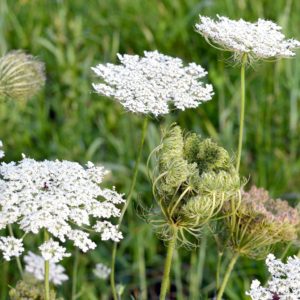

The wild carrot (or Daucus carota) is one of the many gorgeous wildflowers that we include on our rolls of Meadowmat. It is a UK native species of the Apiaceae family that grows primarily on calcareous, free-draining soils. In the wild, it can be found growing in grasslands, on cliffs and even by roadsides.
Appearance
Aesthetically, the wild carrot makes a fine addition to any garden. It flowers between the months of June and August, producing an umbrella-like umbel of small, creamy white flowers. Often, a single dark red flower will grow in the middle of the luscious white umbel, creating a striking visual contrast. The effect is so noticeable that, in North America, wild carrots are colloquially known as “Queen Anne’s lace”, in reference to an occasion when the monarch pricked her finger and got a spot of crimson blood on her pristine white lace.
However, it is worth noting that the wild carrot is a biennial plant, which means that it takes two years to complete its life cycle. As such, you may not see any flowers on your wild carrots until the second year of growth. In the meantime, the plant can still add a decorative flourish to your garden due to its feathery tripinnate leaves.
Wildlife
Not only does the wild carrot prettify your garden with its presence, it also attracts interesting and beautiful insects. When in bloom, the wild carrot is favoured by many pollinators and leaf-eaters, including bees, green lacewings and butterflies. These colourful and diverse bugs are a must-see for any nature enthusiast and will complement the appearance of your Meadowmat.
Uses
Wild carrots don’t just provide food for insects, though, humans can also eat them! When a wild carrot is young, its central taproot is edible, just like that of a domestic carrot (though the root does harden too much to consume as the plant gets older). The small white flowers also have a practical application: they can be used to make dyes for clothes. Of course, we don’t recommend harvesting any part of your Meadowmat when you first lay it. However, once its been established for a few years, you might start to wonder about the practical uses of the plants you’ve been growing. In this case, the wild carrot is a great plant to harvest, thanks to its usability as both a dye and a source of food.
The wild carrot is included in two of our Meadowmat varieties. We recommend it to anyone who wants to improve the appearance of their garden, attract insect life and get the most out of their plants!
Key facts about Wild Carrot
- Height: 50 – 100cm
- Flowering Time: June – August
- Flower colour: White with a pink tinge
- Habitat: Usually found in open spaces like meadows, roadsides, pastures and waste areas.
Wild Clary (Salvia Verbenaca)
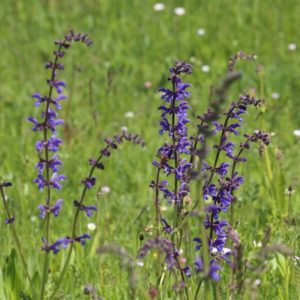

Eagle eyed herb growers will notice the similarities between wild clary and culinary sage. However, these leaves won’t add flavour to your stuffing.
Leaves are distinctive greyish green colour. Stems are square and branched with a slight red tinge to them. The flowers are not particularly showy but look closely and you’ll be fascinated by their curved bottom lip and neat little hood.
Find wild clary in open grassland, sunny banks, sand dunes and roadsides. Well drained soil is important to these plants. In Suffolk particularly Wild Clary is often found in and around churchyards. Although it is native to the UK, populations are quite sparse in most of the country so please don’t harvest it from the wild. And if you can, grow lots of Meadowmat to help preserve this pretty plant.
Where to use Wild Clary
Let’s go back to that association with Suffolk churchyards. This plant was allegedly sown on graves in medieval times because people thought it would give immortality. It’s certainly a long lived perennial plant and so I can see how our ancestors were inspired in their beliefs.
The word “clary” could come from “Clear-eye” because when soaked in water, the seeds produce a jelly like substance. Ancient herbalists used this to sooth and cleanse the eye. Indeed, scientific analysis of the oils in wild clary reveals that the plant has antibacterial, antioxidant, antifungal and anti-inflammatory properties.
In Sicily, Wild Clary has been used in traditional medicine for the treatment of kidney stones.
Wild Clary in Meadowmat
This robust plant has been included in the seedmix for Meadowmat Garden Birds and Bees because it’s so resilient, easy to grow and popular with bees.
As gardeners it’s out duty to support wildflowers that, for whatever reason, are struggling to live in the wild. Could you find a way to include this beauty in your planting plans?
- Long flowering period
- Reliable and very easy to grow
- Pollinator friendly
- Long lived plant
- Frost hardy
- Wild Clary can be dead-headed to prolong the flowering period
- Perfect for a cottage style garden
Key facts about Wild Clary
- Height: 30-80cm
- Flowering Time: May – August
- Flower colour: Dusky blue
- Habitat: Dry grassland – prefers sun
Wild Marjoram (Origanum Vulgare)
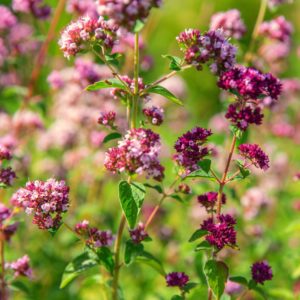

Wild marjoram (scientific name: Origanum vulgare) is a herb with beautiful purple wildflowers, which bloom during July and August. Wild marjoram is a native species in the Mediterranean and parts of Asia but is grown throughout Europe. In the UK, wild marjoram is one of three varieties grown on these soils, the other two being pot marjoram and sweet, or knotted, marjoram. Wild marjoram also goes by the (perhaps more familiar) name of oregano, and is part of the mint family.
It has several reputed medicinal properties and is named by the Royal Horticultural Society (RHS) as the perfect pollinator, attracting bumble bees and butterflies, which in turn support our fragile eco-system.
Growing and harvesting
Wild marjoram is a hardy herbaceous plant which can thrive when planted in the UK. However, it only lasts for one season and rarely survives winter. Sow the seeds in fertile soil in spring – use an individual container if you wish – making sure you choose a sunny spot to encourage the herb’s growth. Once your wild marjoram is ready, make use of this highly versatile and flavoursome herb in the kitchen – add it to pizza, certainly, but try it out in other recipes too!
After summer, the leaves of wild marjoram die back but its roots live on under the earth, resulting in the leaves growing again the following spring.
You can keep things simple and invest in Meadowmat, a pre-grown wildflower meadow that’s as easy to lay as lawn turf. Meadowmat and organisations such as local Wildlife Trusts and the Royal Horticultural Society (RHS) can provide further advice and tips about how to plant wildflowers, and their many benefits.
Traditional uses
Wild marjoram, or oregano, is one of the best known and best loved of all culinary herbs, a staple of pizzas but also adding flavour and an aroma to many other recipes and salads. It has many nutrients too and is packed with antioxidants.
This herb is also known for its medicinal properties. Since ancient Greek times, it has been used to treat sore throats, coughs, tooth aches and digestive problems. It has been used for mouthwashes, cough medicines and antibacterial soap. These days, essential oil from the leaves of wild marjoram is popular; it is used in massage to relax tense muscles or to support the nervous system, and often simply for its pleasurably warm, soothing aroma.
Key facts about Wild Marjoram
- Height: 50-100cm
- Flowering Time: July – September
- Flower colour: Dark Purple
- Habitat: Grasslands, hedgerows, banks, verges, and scrubland.
Wild Mignonette (Reseda lutea)
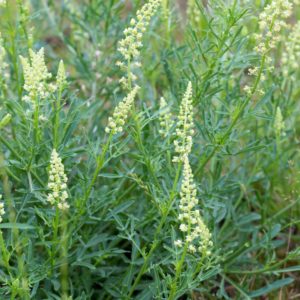

Key facts about Wild Mignonette
- Height: 10-100cm
- Flowering Time: May – September
- Flower colour: Yellow with a green tinge.
- Habitat: Grasslands, hedgerows, banks, verges, and scrubland.
Wild Pansy (Heartsease)
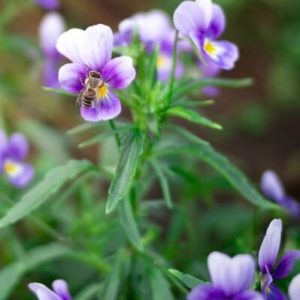

Most gardeners can recognise a pansy when they see one. The wild pansy is far more petite and delicate looking than their colourful cousins who adorn garden centres.
The wild pansy, also known as heartsease has pretty little flower heads with yellow centres. Their colour varies from blue-violet, to pale yellow and sometimes almost white. Petals should be longer than the sepals. If they’re not, you’re probably looking at a field pansy.
Where to use Wild Pansies
These beauties were once common place in the countryside. However, like so many other wild plants, the way we manage our fields and road verges has created conditions that wild pansies just don’t like.
Gardeners can help by letting them grow undisturbed in wildflower areas. If they love your garden, wild pansies, which are short-lived perennials, will self-seed and form wonderful colonies.
Wild pansy flowers are edible. Add them to your salads, cakes and desserts for extra colour. If you like crafting, these flowers are easy to preserve by pressing and can be used to decorate cards etc.
Medicine and Folklore
There are a wealth of stories about wild pansies in folklore and mythology. In general they are associated with love, death and rebirth.
Placing wild pansies under your pillow is said to attract a new lover. Planting them in a heart shape will help your relationship to thrive. The Celts used the dried leaves to create love potions.
Rumour has it that picking the flowers on a sunny day will cause a storm to come. Picking them whilst the dew is still on them will bring death to a loved one.
Medicinally, the name Heartsease comes from its use for heart conditions. Wild pansy is also used to relieve catarrh, arthritis, prostrate inflammation and cystitis as well as various skin conditions.
Key facts about Wild Pansy aka Heartsease
- Height: 20-30cm
- Flowering Time: April – July
- Flower colour: Violet
- Habitat: Dry and disturbed areas, loves dunes, heaths and hills
Wild Thyme (Thymus Polytrichus)
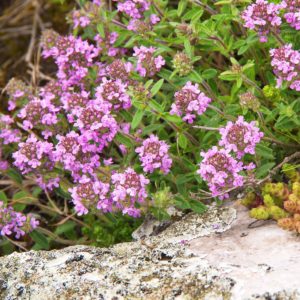

Wild thyme, or Thymus polytrichus, is a species of the Lamiales order of wild flowering plants, and is in fact a low growing member of the mint, or Lamiaceae family. This ground covering plant rapidly forms dense mats due to its extensive downy runners, and as such is perfect for the Meadowmat concept.
What does Wild thyme look like?
Wild thyme rarely grows past a few inches in height and features square stems, two sides of which are hairy, leading to fuzzy, deep blue-green, oval leaves. These leaves are extremely aromatic, not dissimilar to oregano, but the exact degree of aroma generally depends on the time of year and situation of the plant. In summer time, there are clusters of beautiful purple to lilac-pink flowers, each averaging around 5mm in diameter. It is this blanket of purple wild flowers that creates the striking effect this plant is famous for, adding splashes of colours to sun-drenched meadows and heath-land.
There are a number of subspecies of Thymus polytrichus, but the native species to the United Kingdom, the subspecies Britannicus, is widespread throughout Great Britain and Ireland, as well as vast parts of Western Europe.
Where to find Wild thyme
This perennial herb flourishes most favourably upon free-draining, neutral to alkaline rich substrates, such as sands, limestone, chalk and gravel. Therefore, the wild thyme is often found on heaths, sand dunes, downland, cliffs, and even mountain ledges. It is also an extremely hardy species, being especially frost and wildlife tolerant, as well as requiring minimal water to survive. The wild thyme’s only weakness is extreme humidity, where ample air circulation is required for optimum health.
The characteristics of this low to zero maintenance plant show why it is a favourite staple among wild meadow cultivators and the Meadowmat concept.
This hardy, evergreen plant happily survives all year round, even in gaps between patio slabs, and generally blooms around June to July time.
A good plant for attracting wildlife
As well as being low maintenance and providing a beautiful blanket of colour, the wild thyme attracts a whole host of fauna. Bees are particularly fond of this plant, especially the honey bee and red mason bee. Other common visitors include many species of butterflies and moths, as well as their associated predators, such as small, garden birds.
Using Wild thyme in the home
The most obvious use for this herbaceous perennial is in cooking, where it’s fragrant scent and taste can be used as a beautiful seasoning, particularly for poultry and pork. Medicinal uses for wild thyme and its oils include as a digestive tonic and mild antiseptic.
Key facts about Wild Thyme
- Height: up to 10cm
- Flowering Time: June – August
- Flower colour: Red-purple
- Habitat: Dry grassland, heaths and sand dunes.
Wood Sage (Teucrium scorodonia)
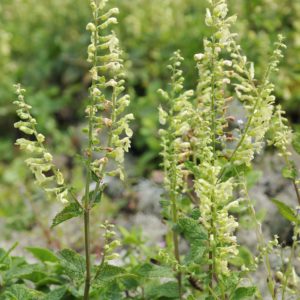

I wouldn’t class wood sage as a pretty flower. It’s not particularly colourful or eyecatching, nevertheless, it has a beauty all of its own. Also known as wood germander
Wood sage has leaves that are deeply crinkled. The branching flower spikes turn into the most elegant seed heads you’ve ever seen. Leaves are 3-7cm long, soft and downy and very much like the edible sage you probably have growing in your herb garden.
Where to use Wood Sage
Sometimes a garden needs something to balance out a riot of colour, to provide texture or depth to a planting scheme. This happy little plant is a great candidate for this. The species is happy to be mown every so often and doesn’t mind a bit of shade. It’s just a nice, easy going kind of a plant.
As an added bonus, the flowers of wood sage are highly attractive to bumble bees and honey bees.
Medicine and Folklore
Interestingly, Wood Sage was used in times past to brew beer. However, There’s a good reason why this plant is no longer used. I’ll let you read this article to find out why wood sage was replaced by hops in the brewing industry.
Wood Sage and Meadowmat
We’ve added this species to the seedmix of two of our Meadowmat products. Species rich lawn meadowmat and woodland shade meadowmat. It’s just such an easy plant to grow and care for. Great for pollinators – and you know how important they are to the Turfonline Team – and just too good to overlook.
Key facts about Wood Sage
- Height: 10-50cm
- Flowering Time: July – September
- Flower colour: Pale yellow-green
- Habitat: Well drained soils, woodland, hedgerows, scrub, heaths, coastal dunes, shingle
Yarrow (Achillea Millefolium)
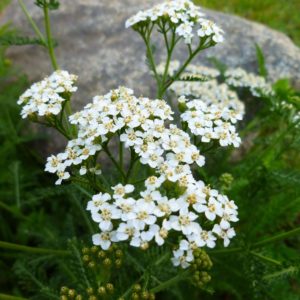

Common yarrow (Achillea millefolium) is an attractive, accommodating perennial, which has many practical uses as a medicinal herb and edible plant, as well as being attractive to butterflies, bees and insects.
The white wildflower can be found growing upright or in clumps and enjoys full sun in exposed or sheltered spots, says the UK’s leading plant organisation, the Royal Horticultural Society (RHS). Particularly tolerant yarrow prefers well-drained soil, but is happy in others, and grows in acidic, neutral or alkaline conditions.
The herbaceous perennial, which grows up to 90cm high and 60cm wide within five years, has cheerful, cream or pink flowers in summer and feathery, segmented green foliage, which is why it is called plumajillo (little feather) in Latin America. Each cluster consists of up to 40 tiny flower heads surrounded by up to eight small petals, which typically bloom in May and June.
The sweet-smelling native species, which is just one of the 42 wildflower species in the Birds and Bees Meadowmat Mix, is perfect for attracting pollinators and is often seen in wildlife or naturalised gardens. Kitchen gardeners use it as a companion plant, as it is popular with predatory wasps, hover-flies and ladybirds that are beneficial against various pests.
Traditional uses for yarrow
Yarrow has been traditionally used to prevent bleeding, which is why it was given the name Achillea, from the mythical Greek Trojan war hero, Achilles. He is reputed to have used yarrow to heal wounded soldiers, which is why the plant is commonly called soldier’s woundwort and thousand seal. It is also known as nosebleed, because the leaves encourage clotting.
Native North American people have many uses for yarrow, and pioneered the use of its stalk to relieve fevers, help against toothache, combat swelling and bruising and treat stomach ache, rashes, haemorrhoids and itching. According to Chinese texts, yarrow boosts intelligence and brightens the eyes. Others use it in tea to find relief from allergies, and it has also been used in the past to flavour beer.
Throughout its history, yarrow has also been used as a vegetable, as its young leaves can be cooked like spinach and added to soups, and they can also be dried and treated as a herb.
Common yarrow can be propagated by seed or through dividing the root-ball in spring, and is ideal for cut and dried flowers.
Key facts about Yarrow
- Height: 10-50cm
- Flowering Time: June – August
- Flower colour: White aromatic flowers
- Habitat: often found in grasslands, lawns and meadows.
Yellow Horned Poppy
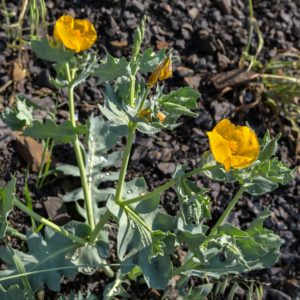

Yellow Horned Poppy is a coastal plant that can be identified by its golden yellow flowers followed by there curling seed pods. If the Yellow Horned Poppy is broken it realises a poisonous yellow sap.
Key facts about Yellow Horned Poppy
- Height: 10-50cm
- Flowering Time: June – September
- Flower colour: Golden Yellow
- Habitat: often found in grasslands, lawns and meadows.
